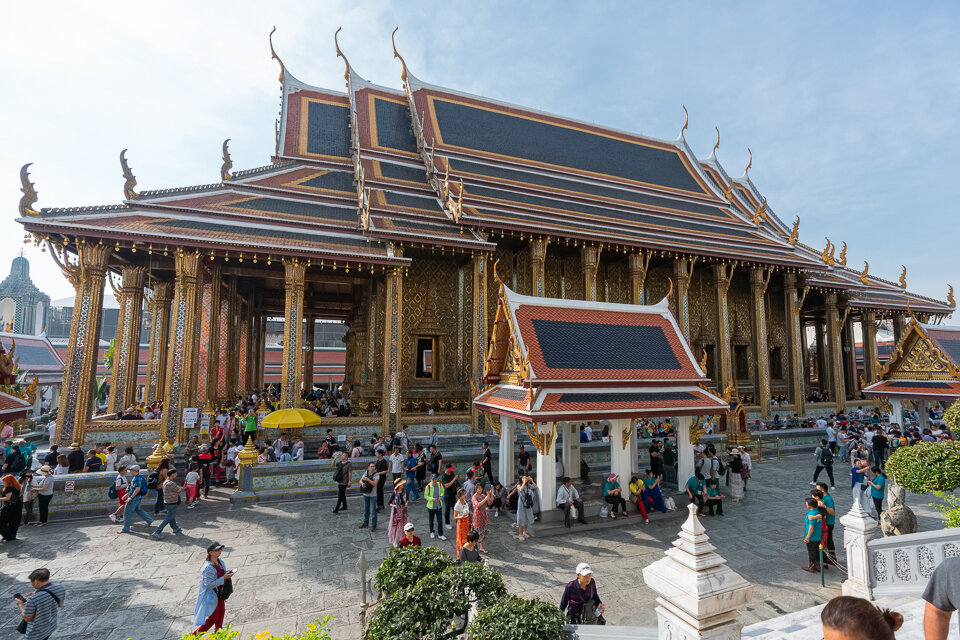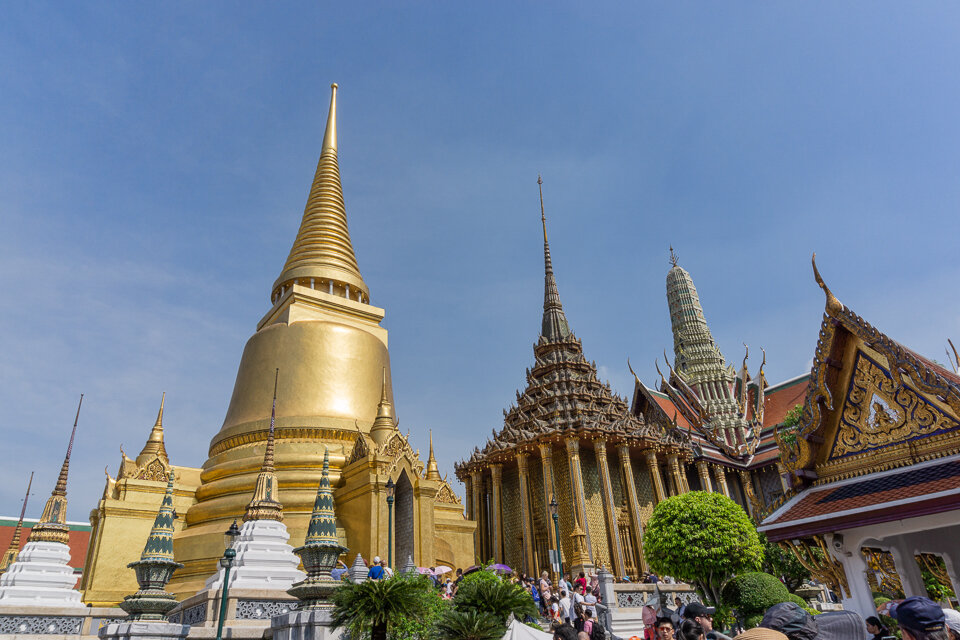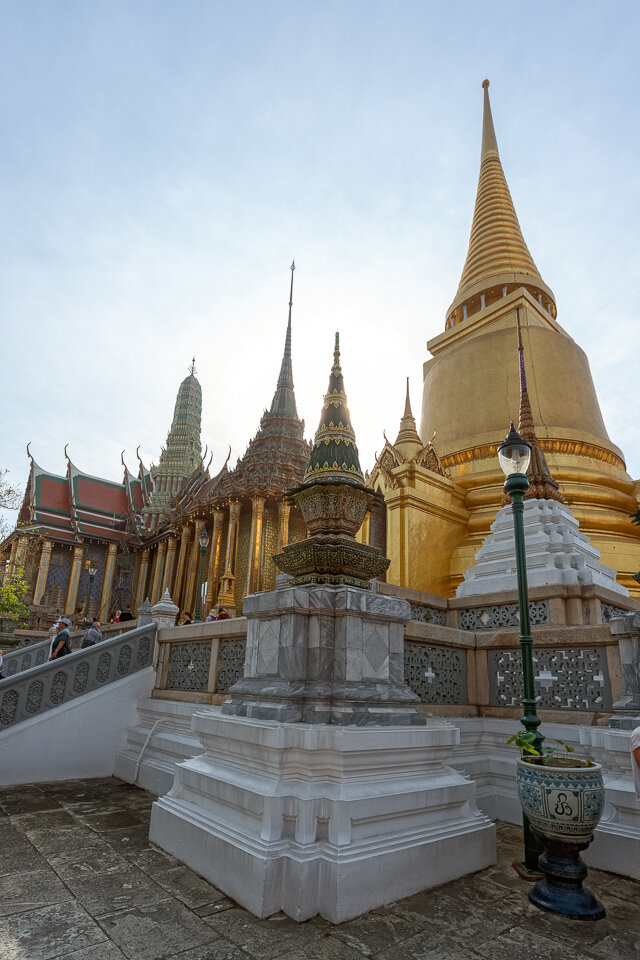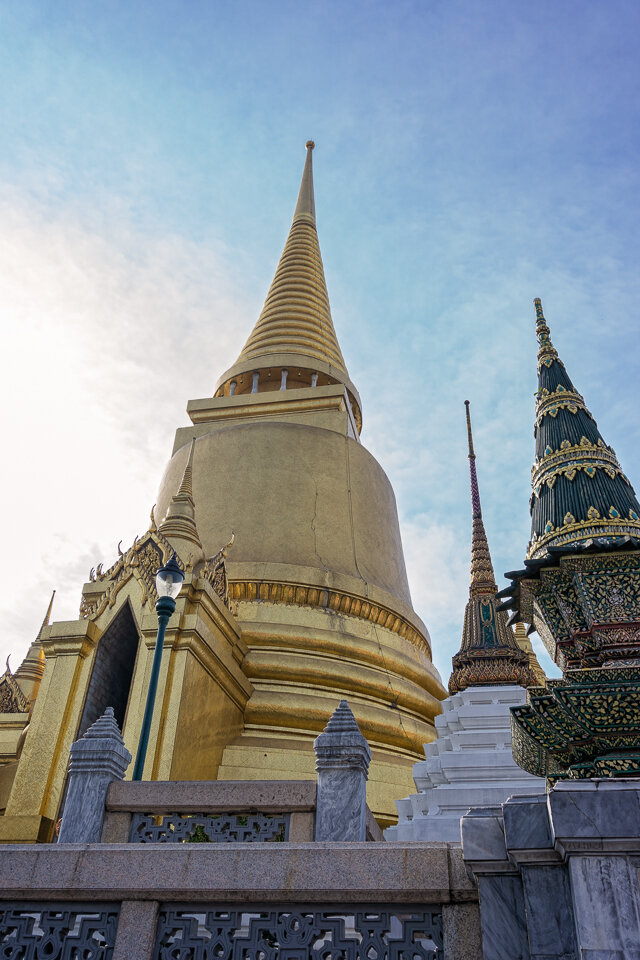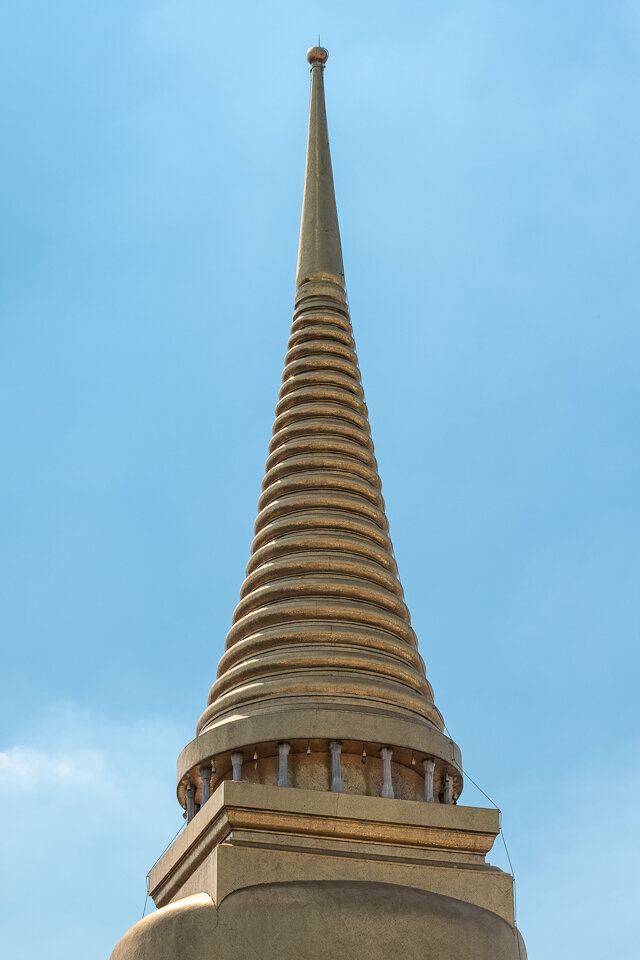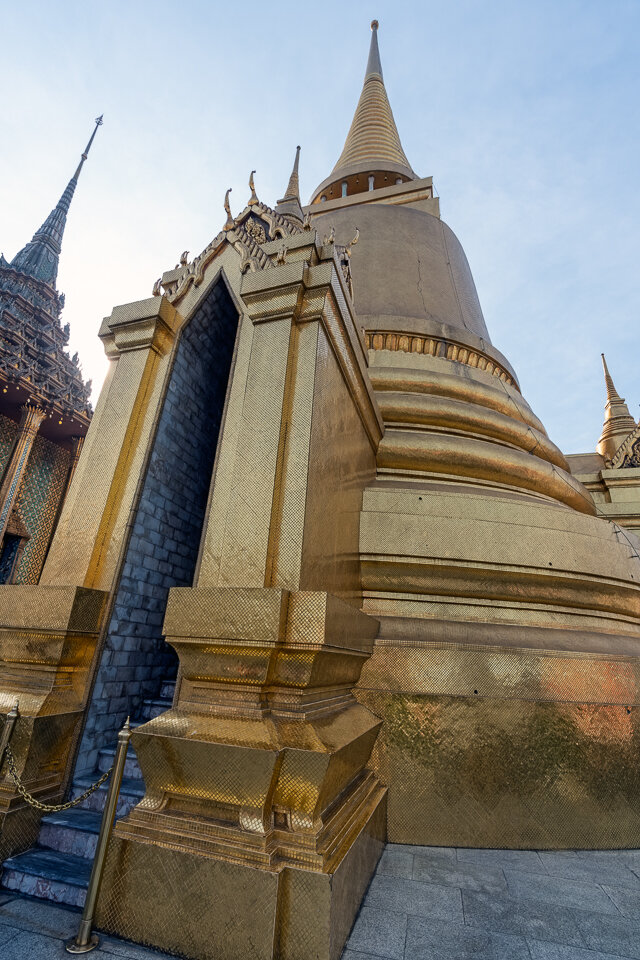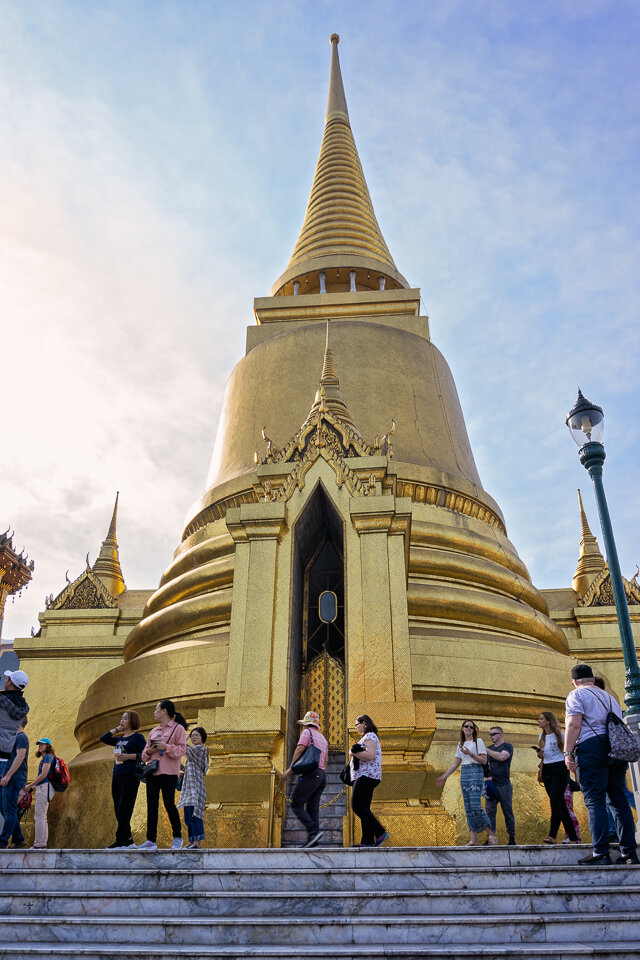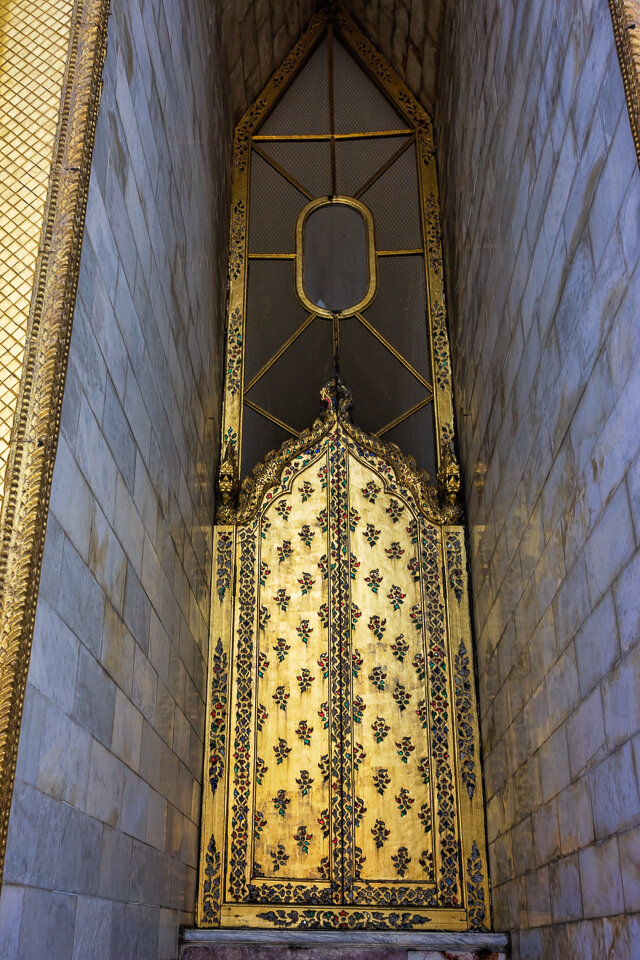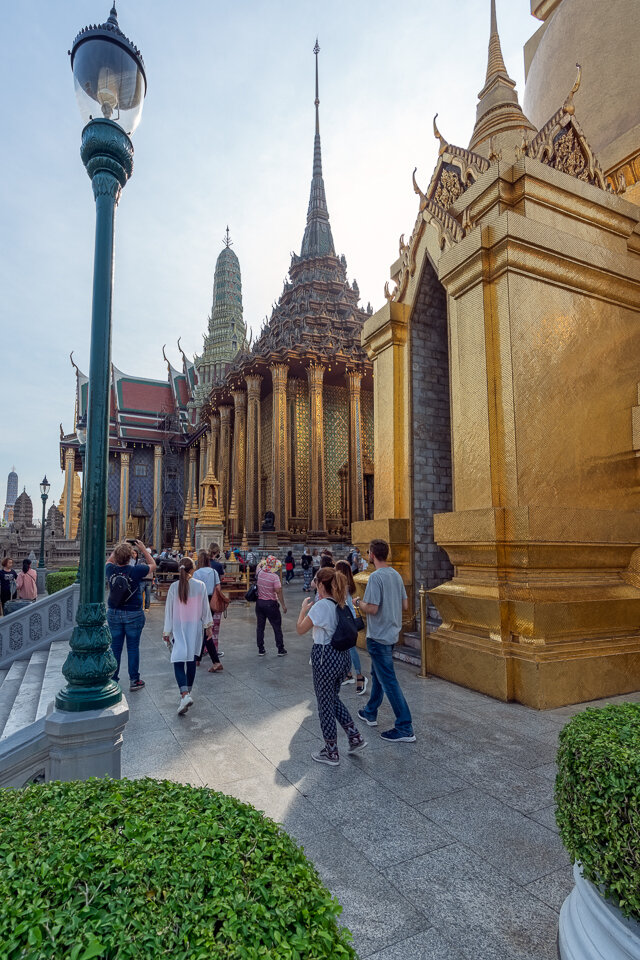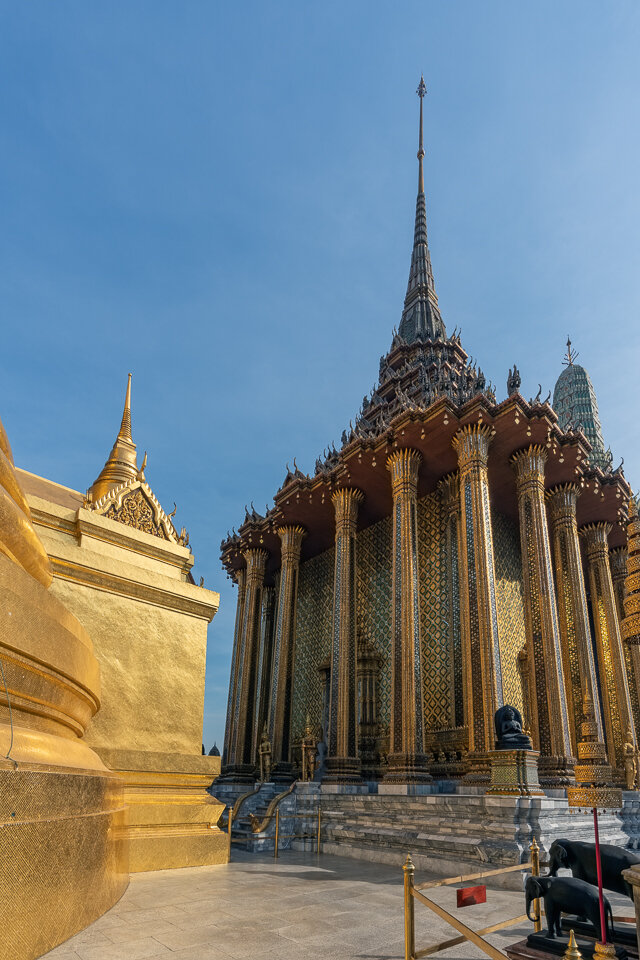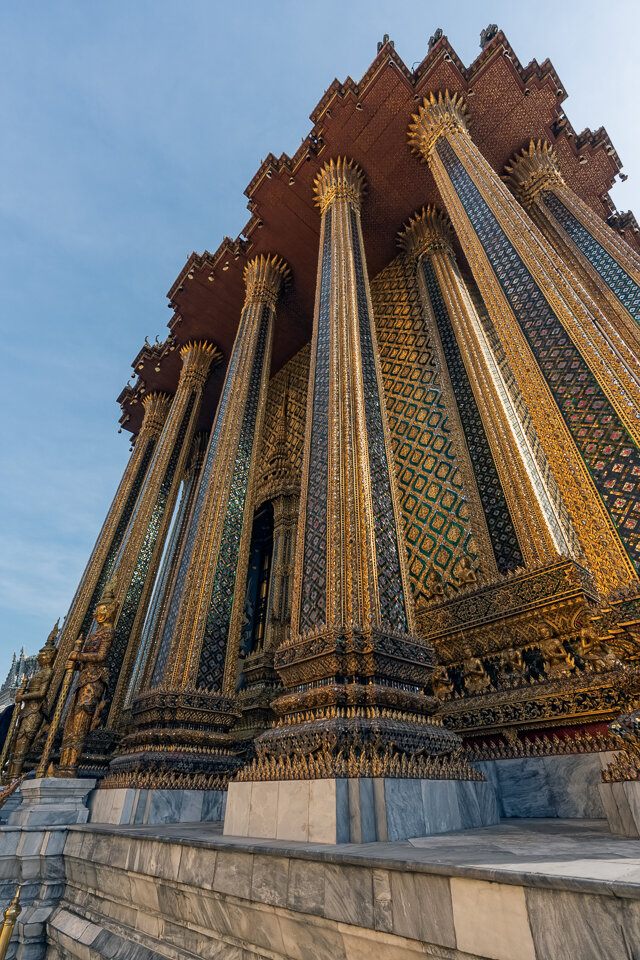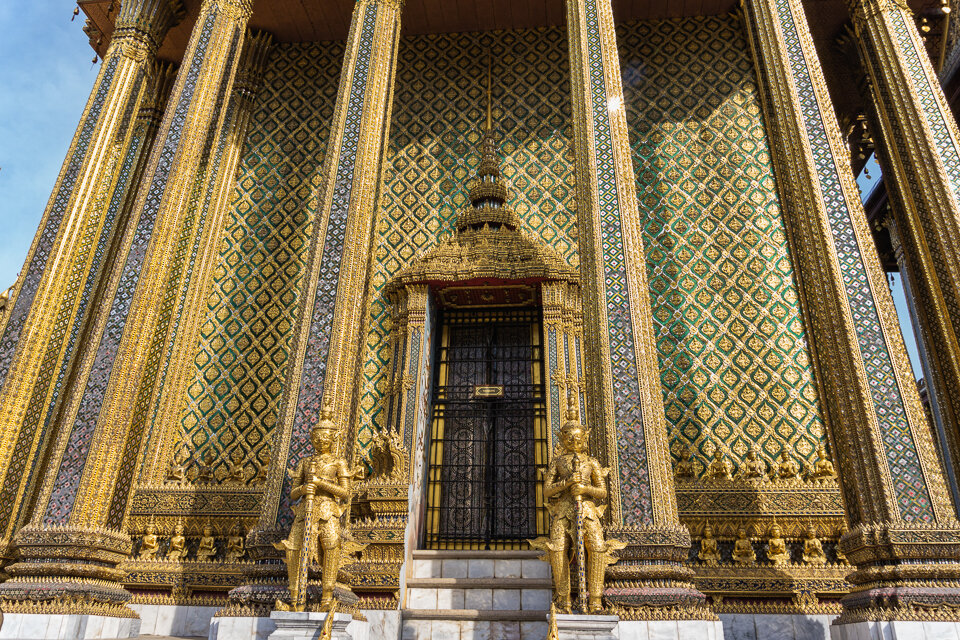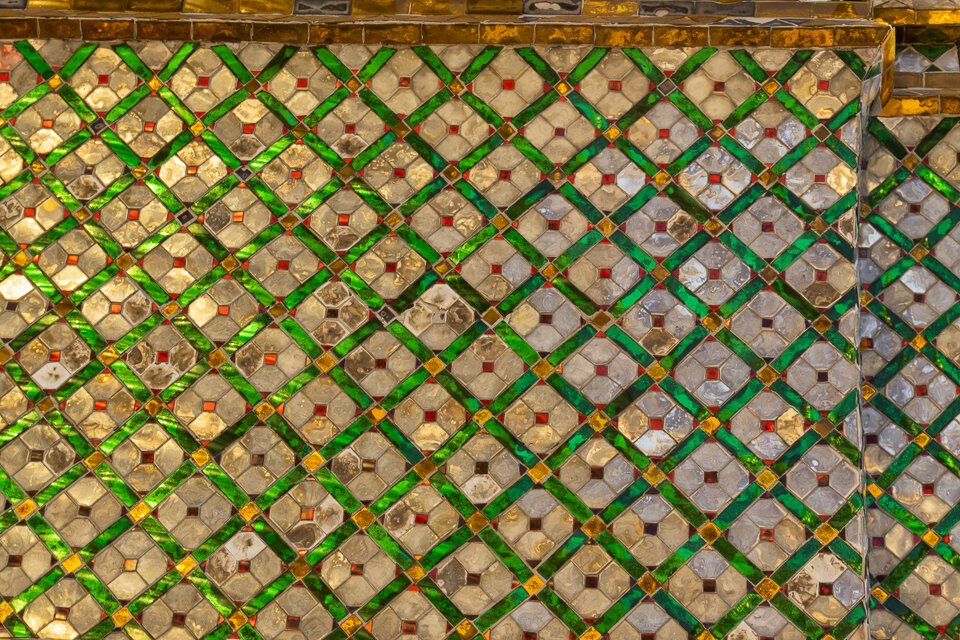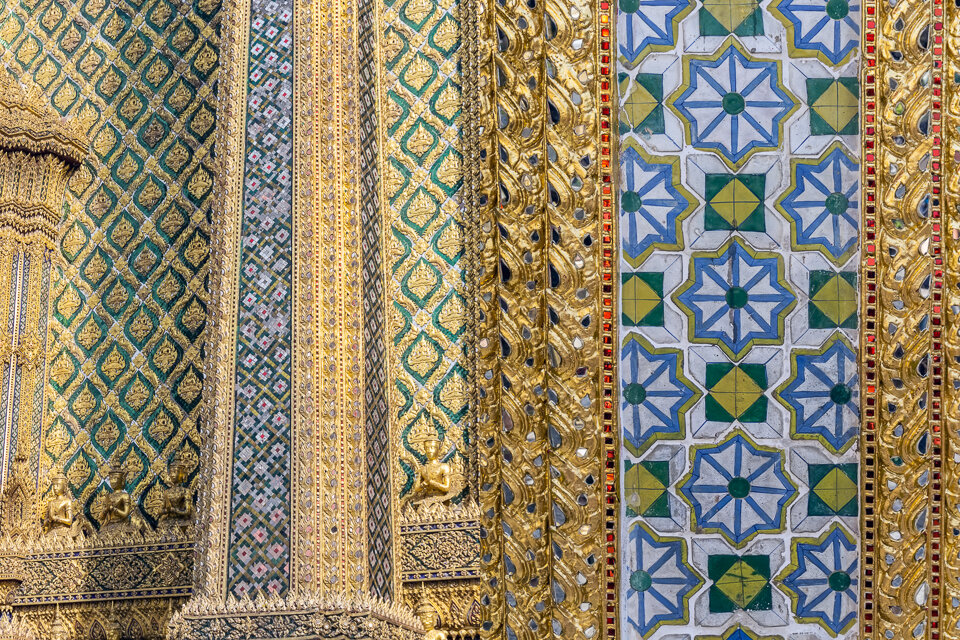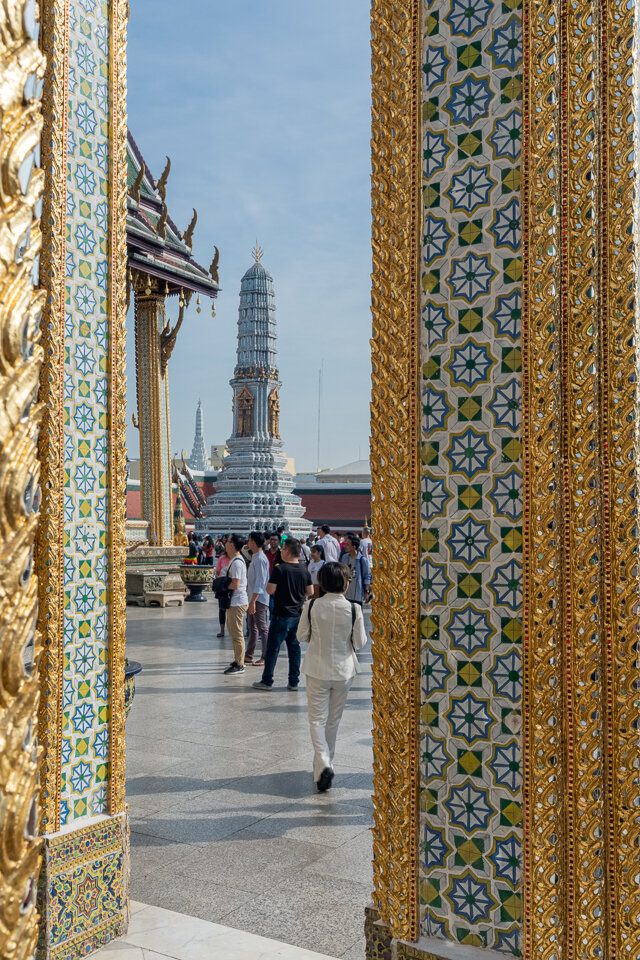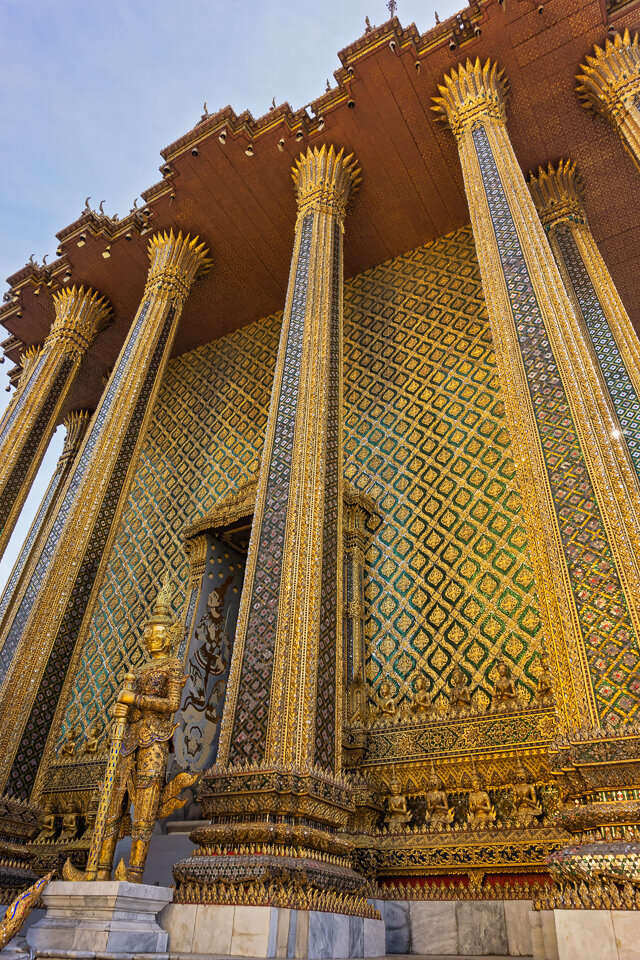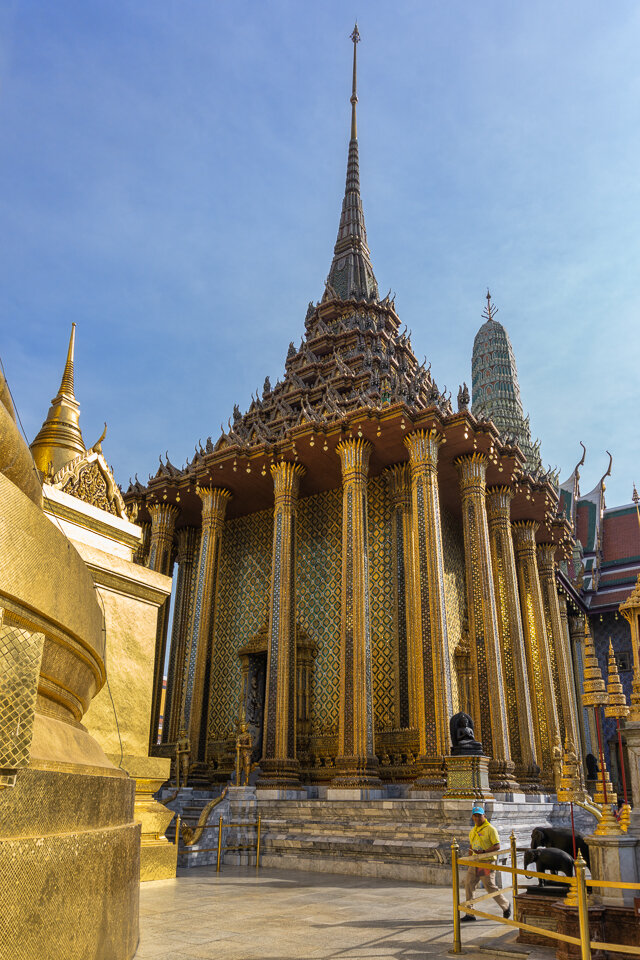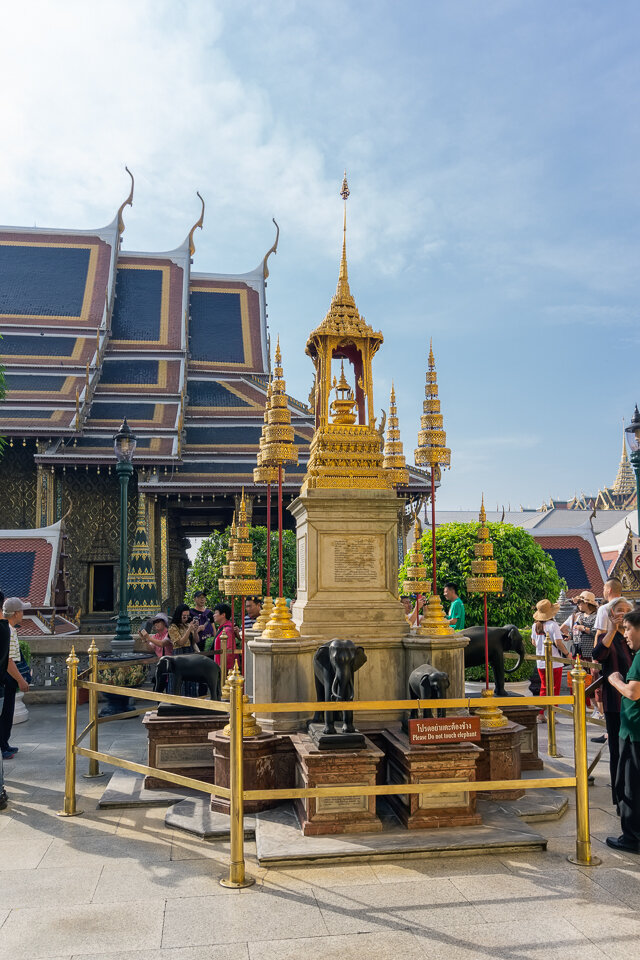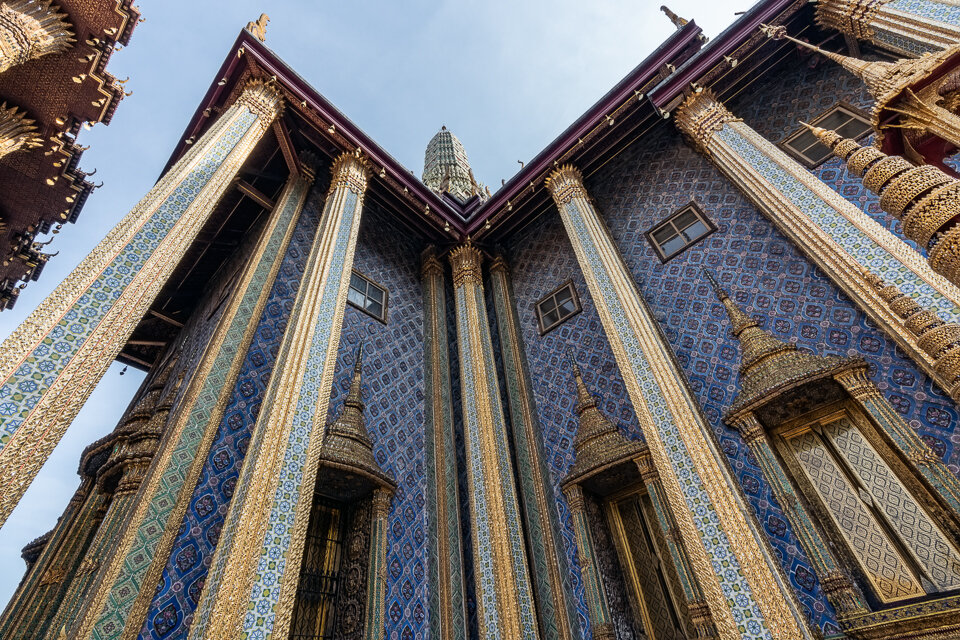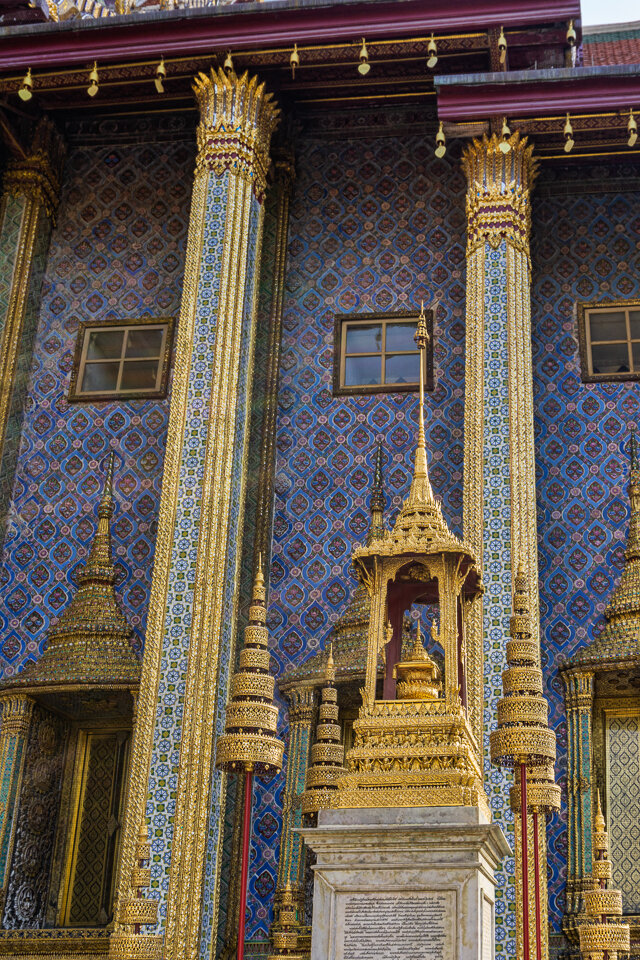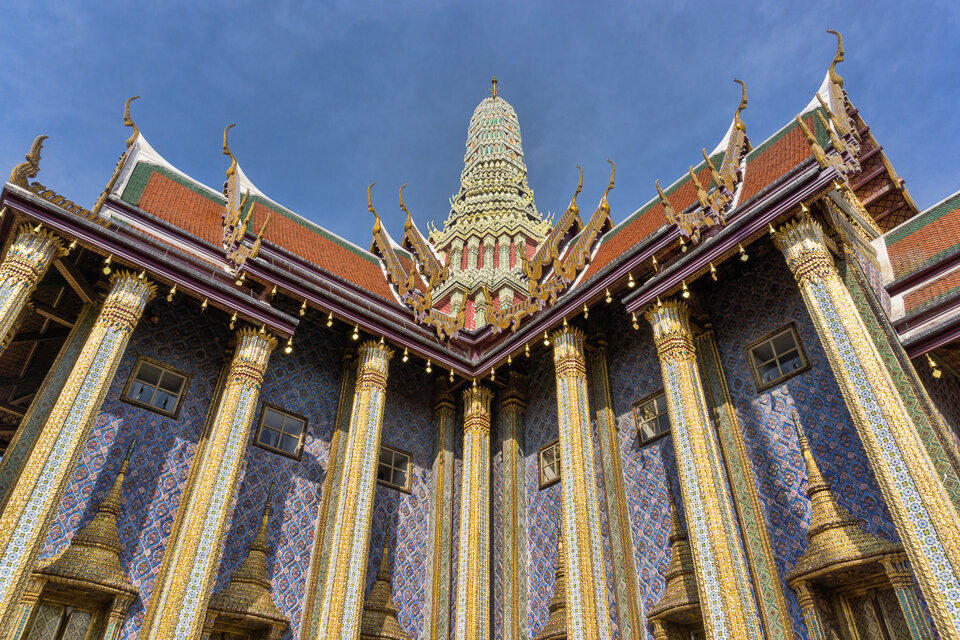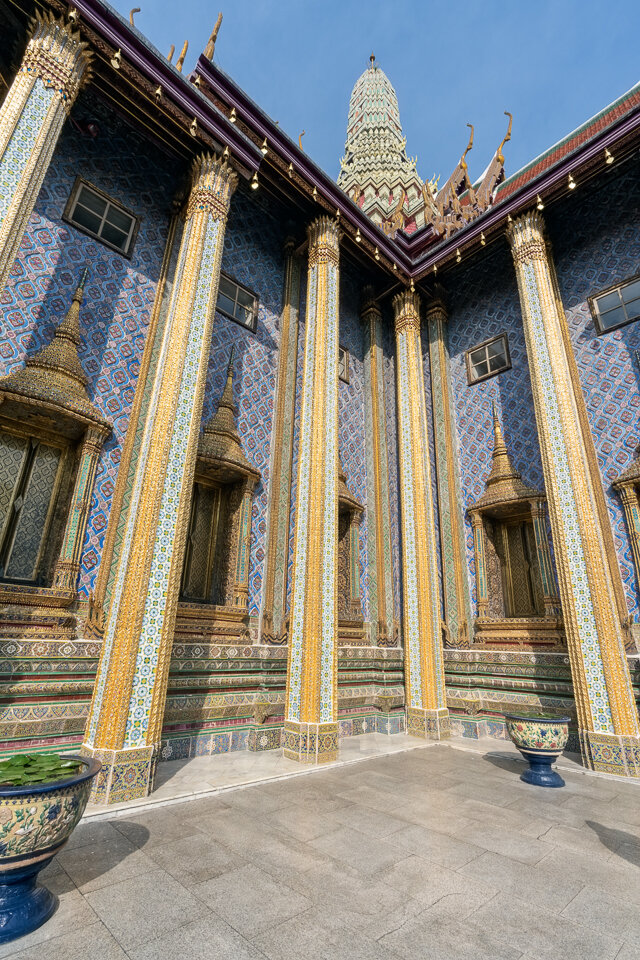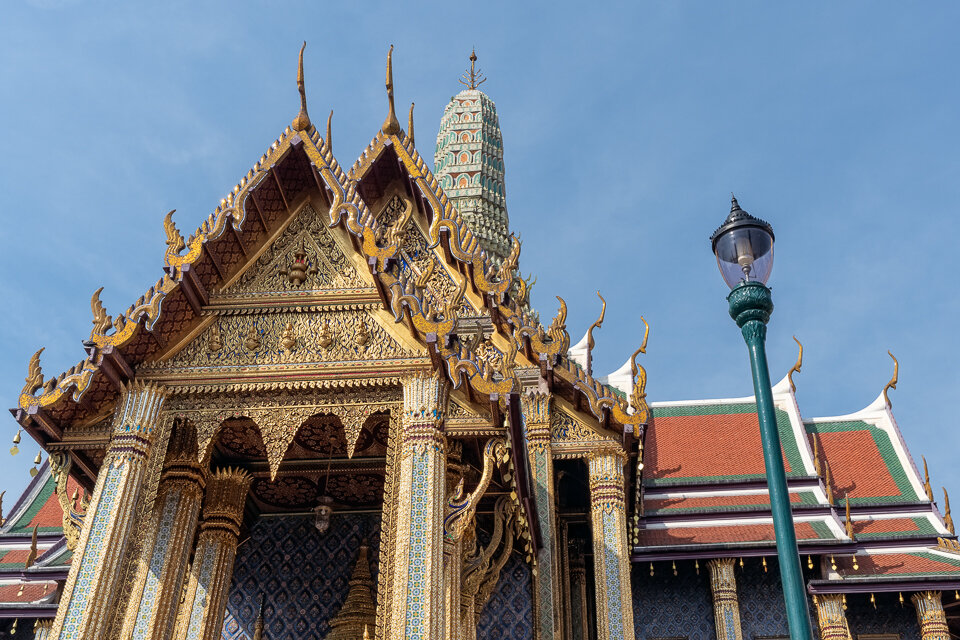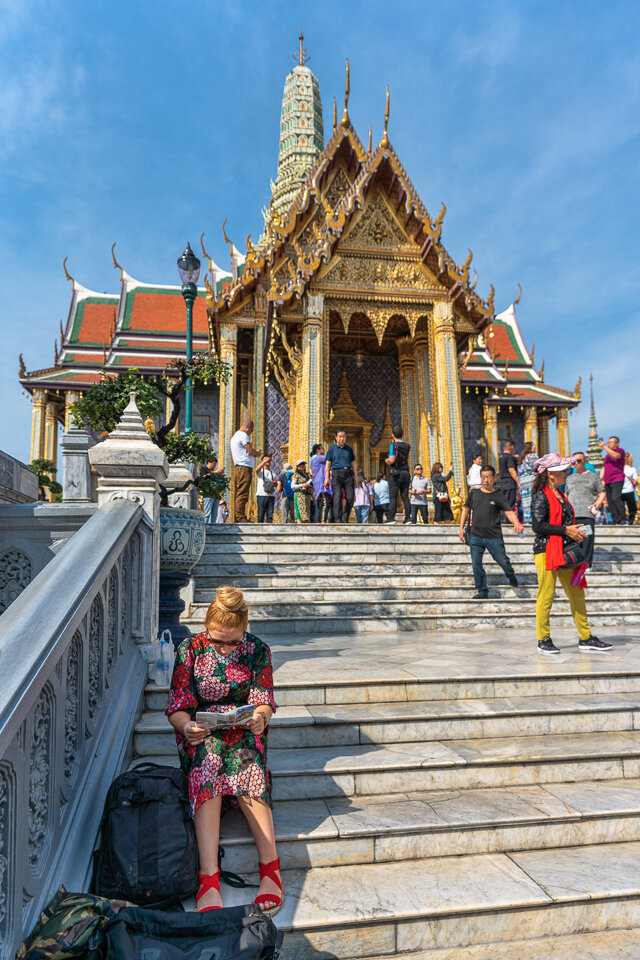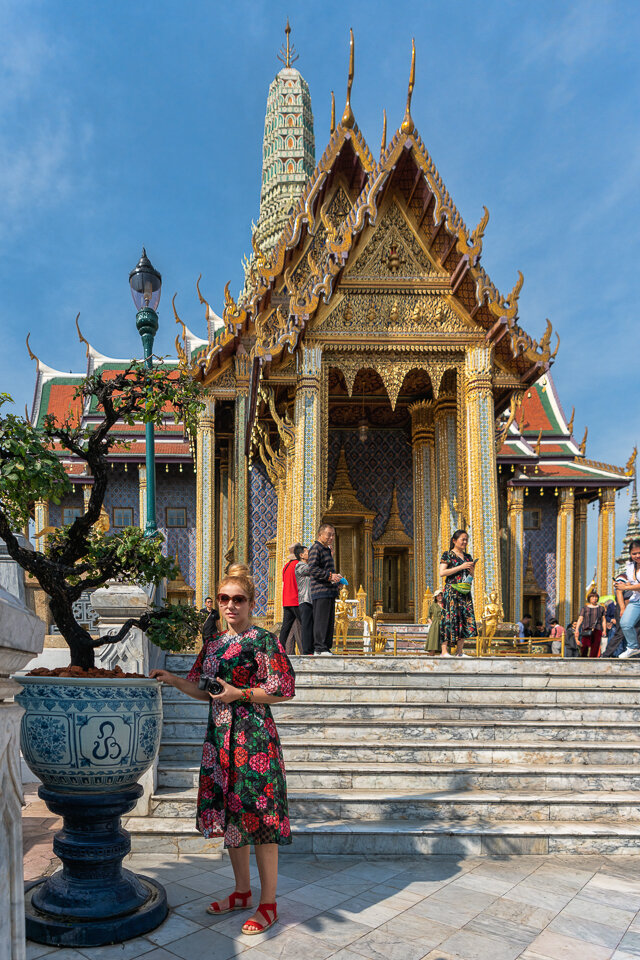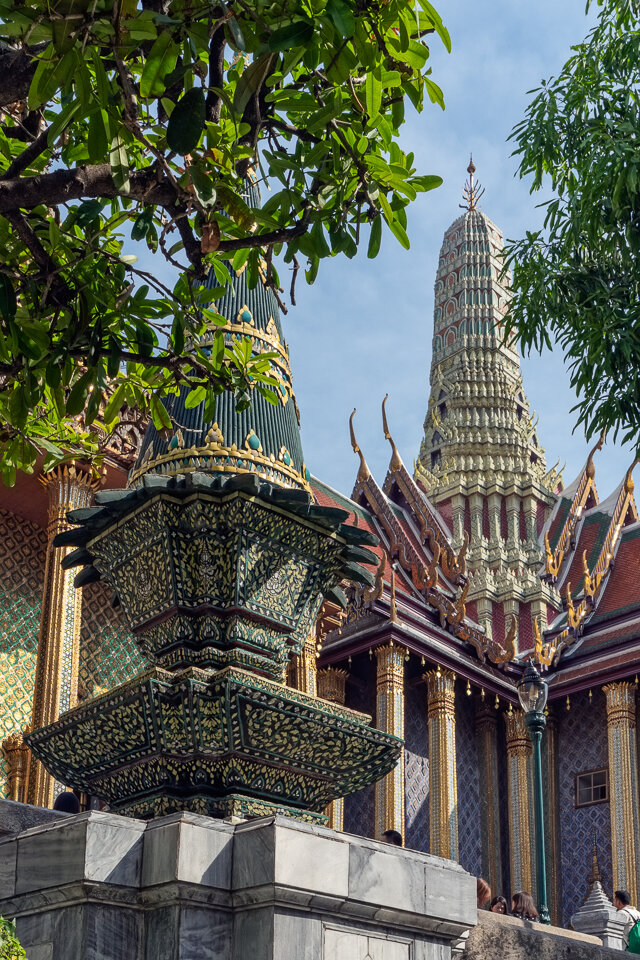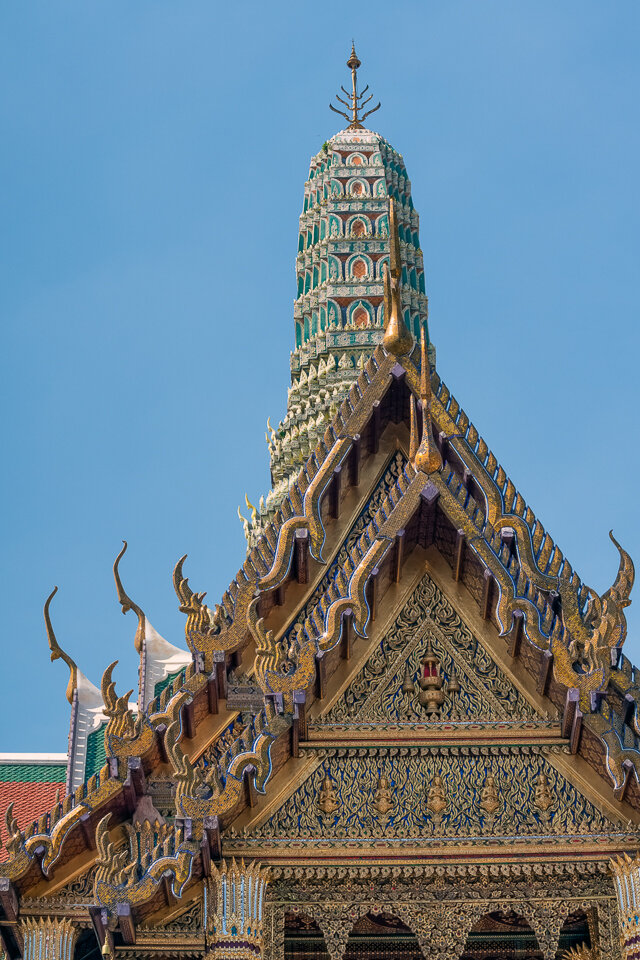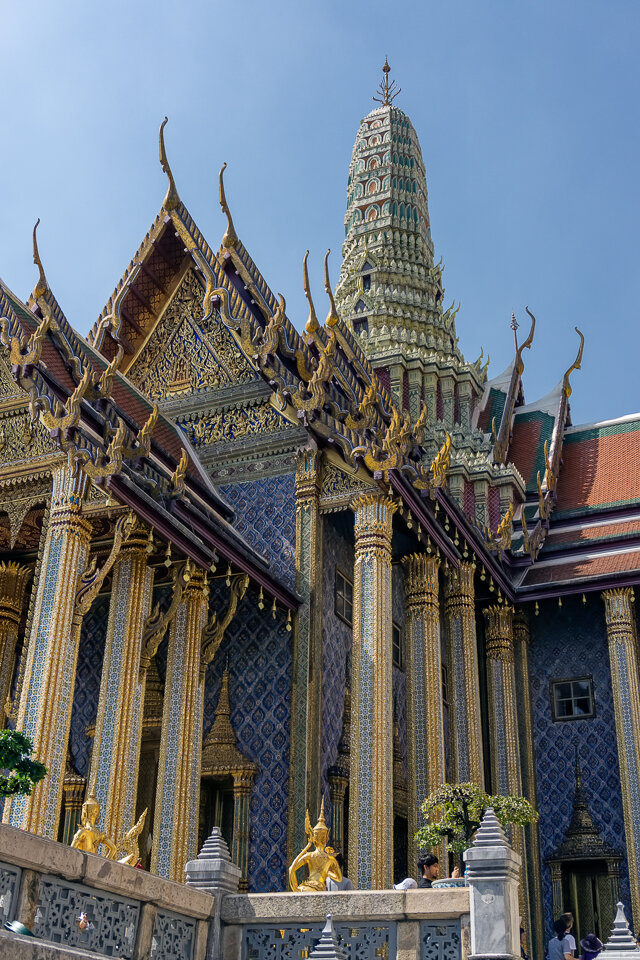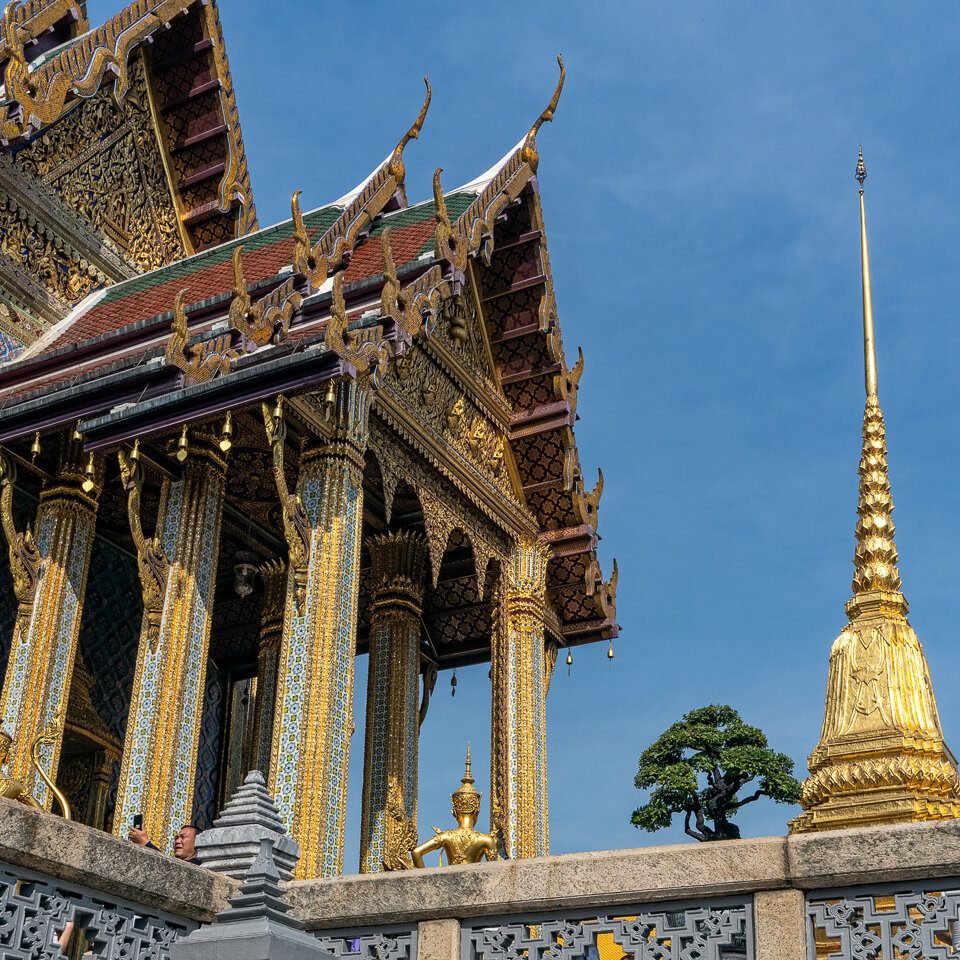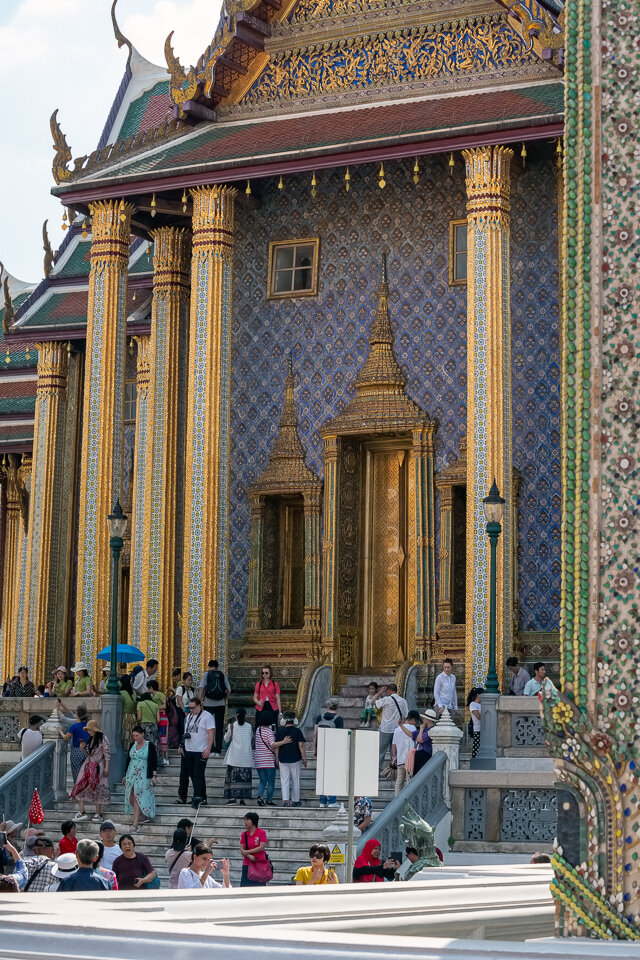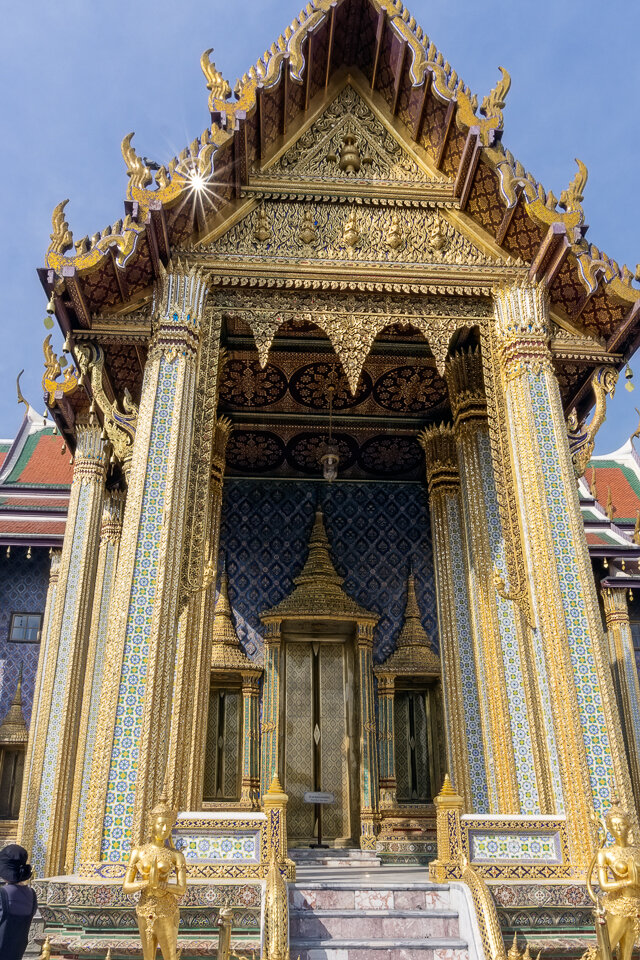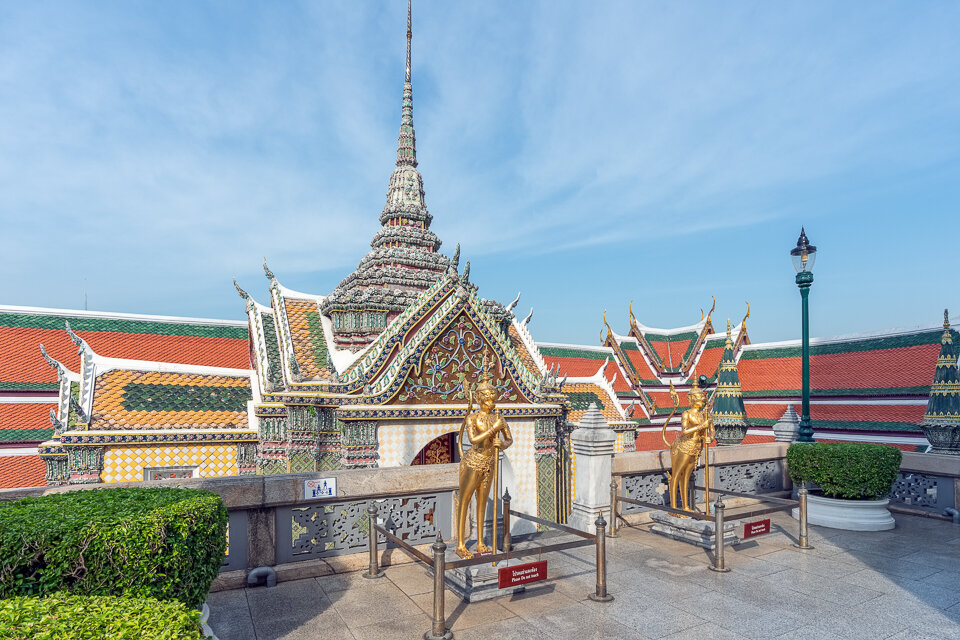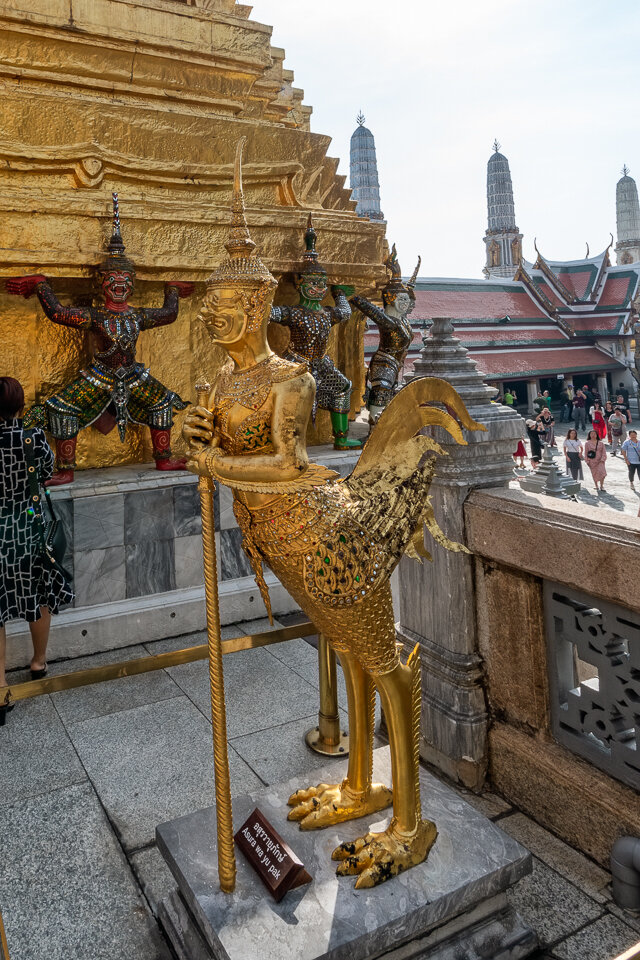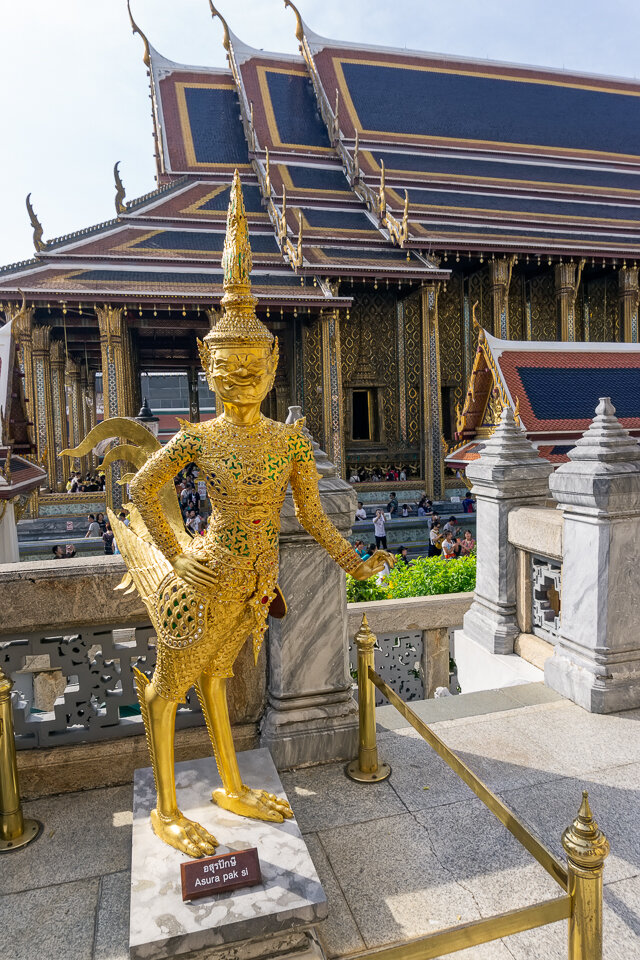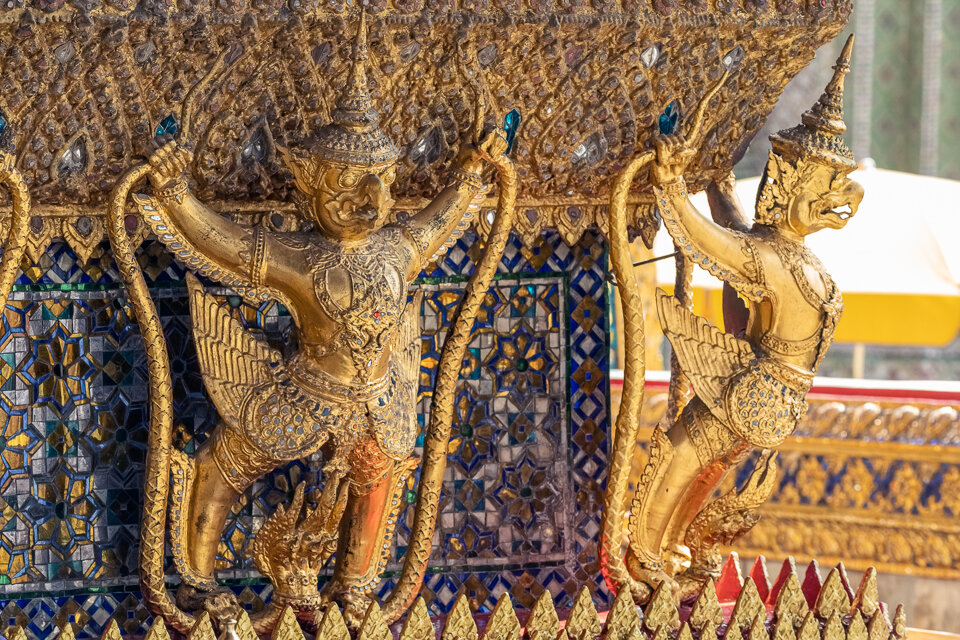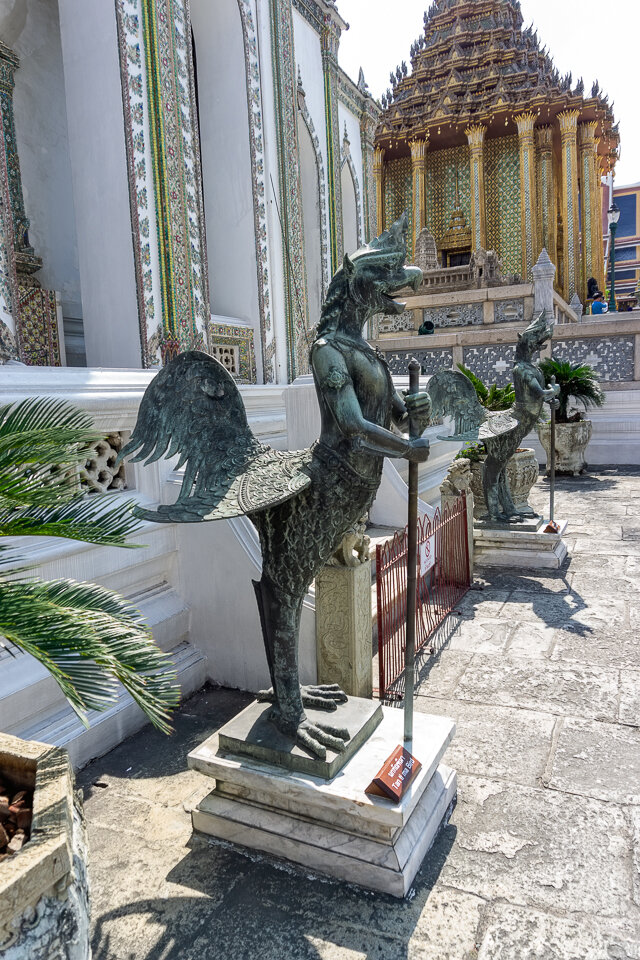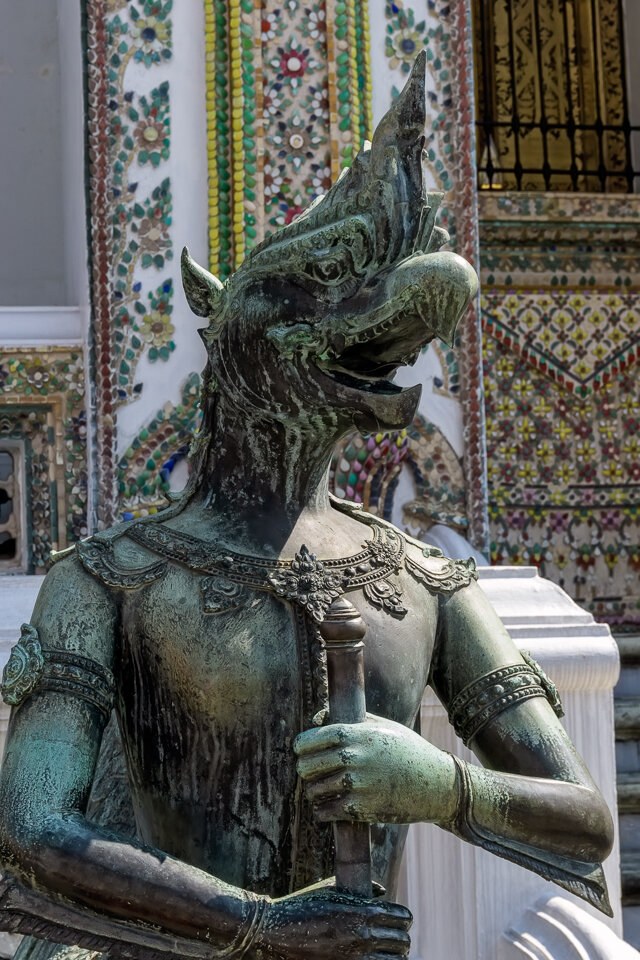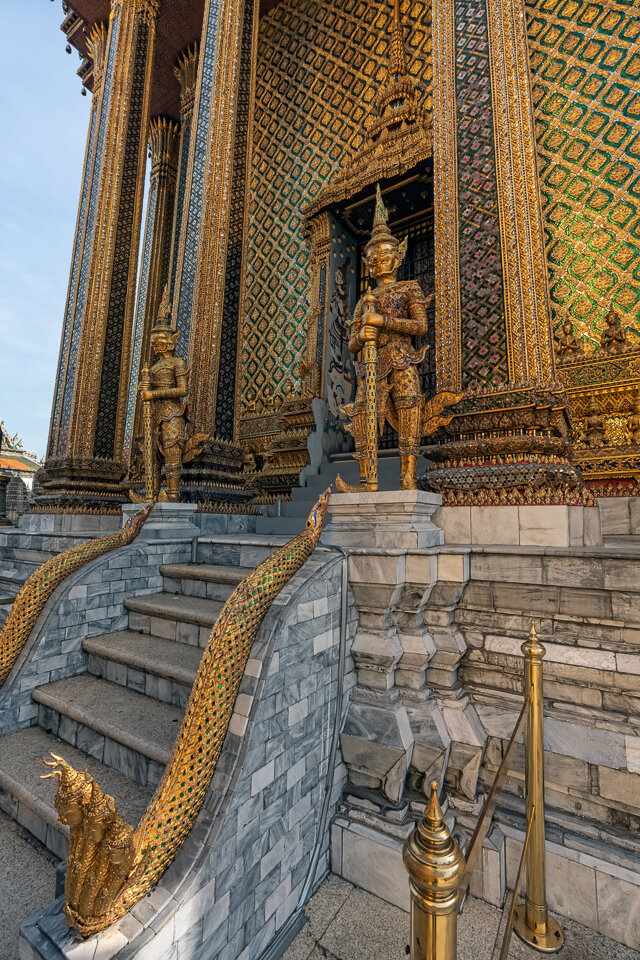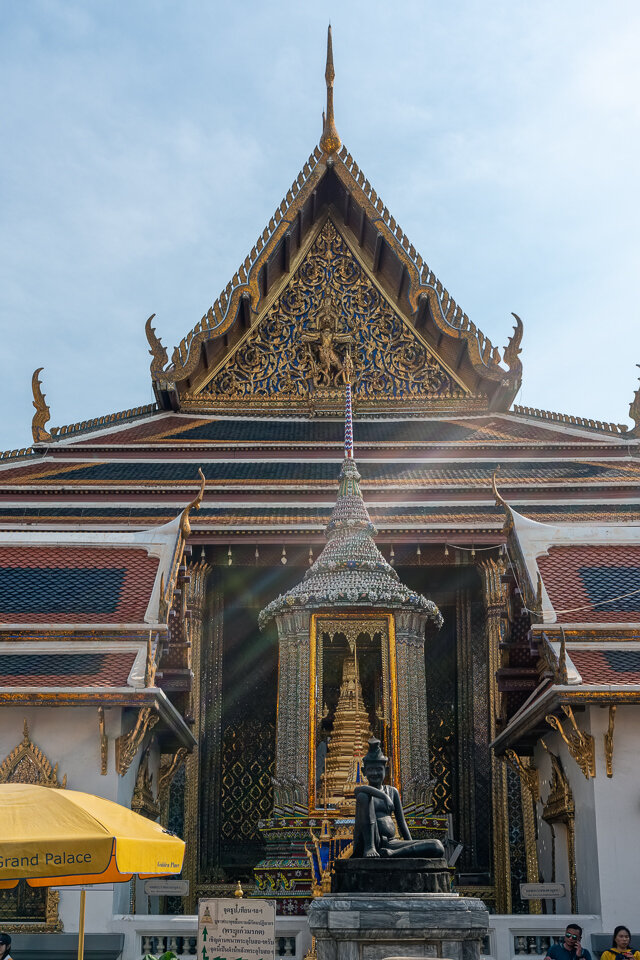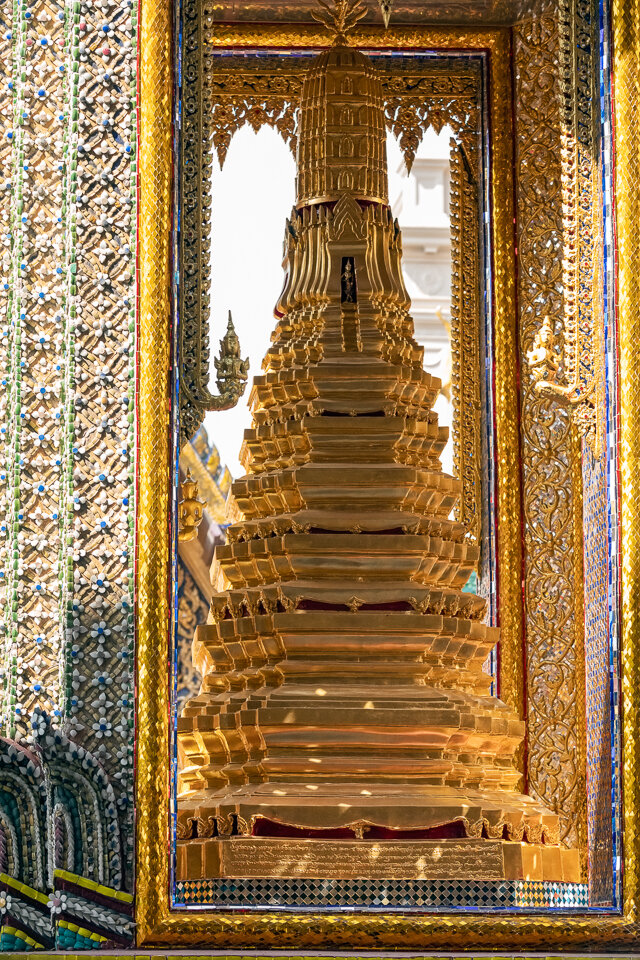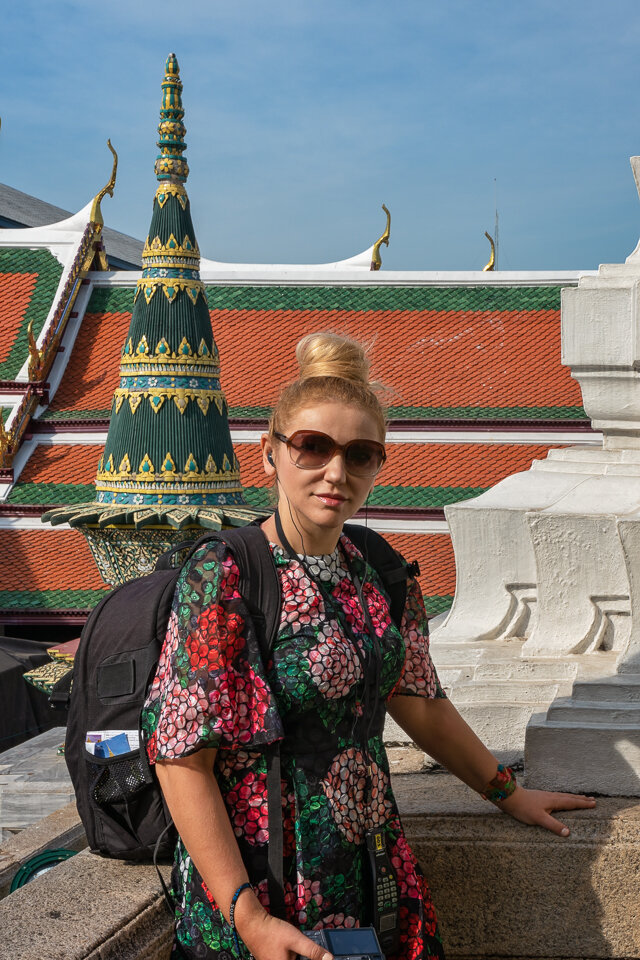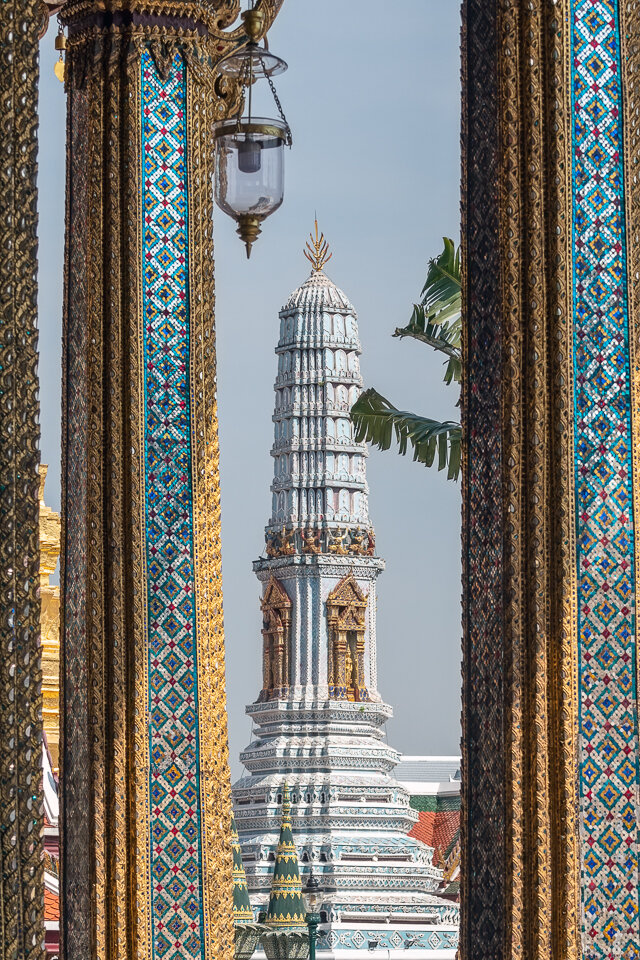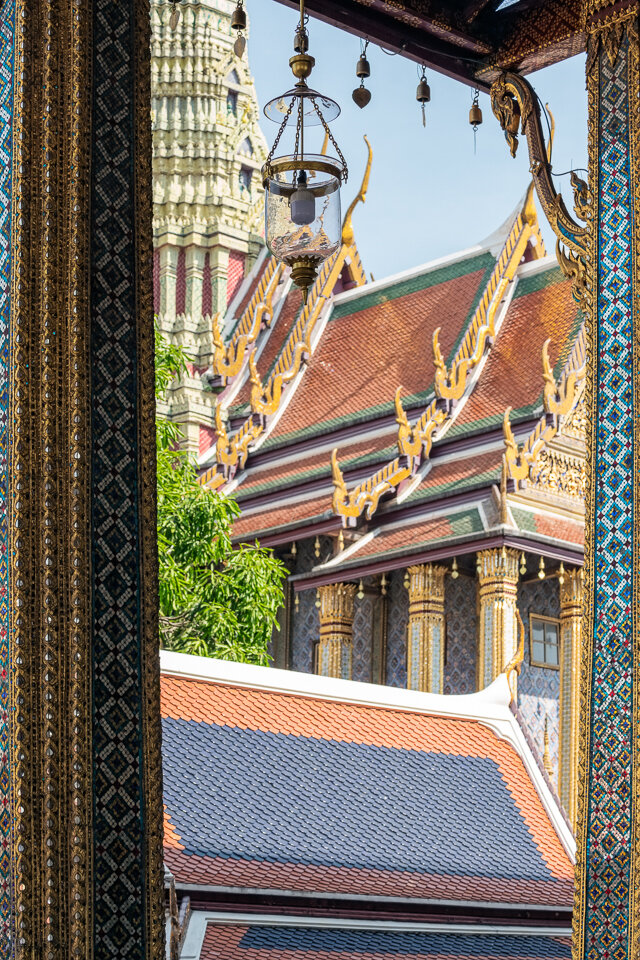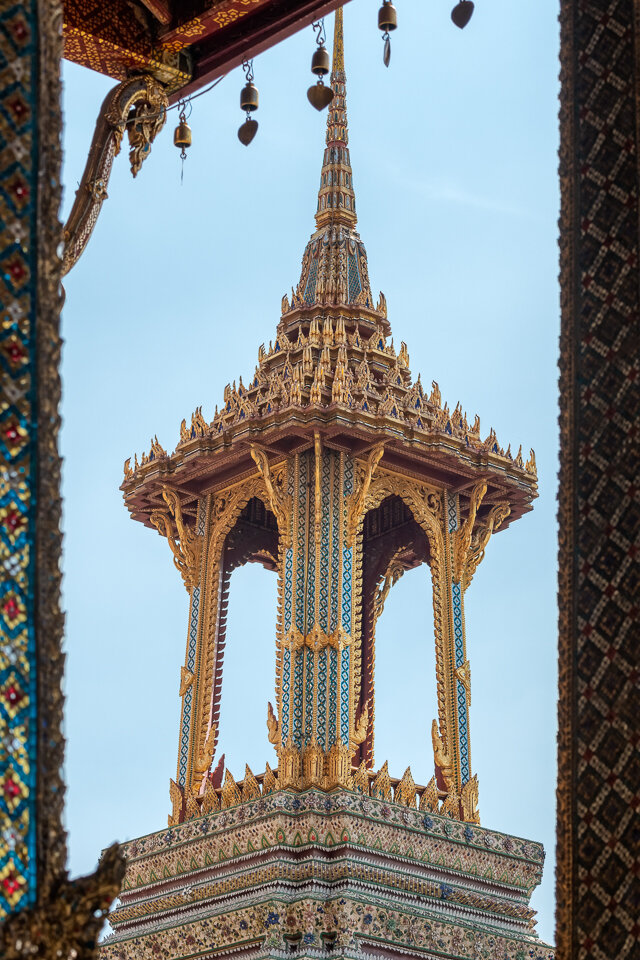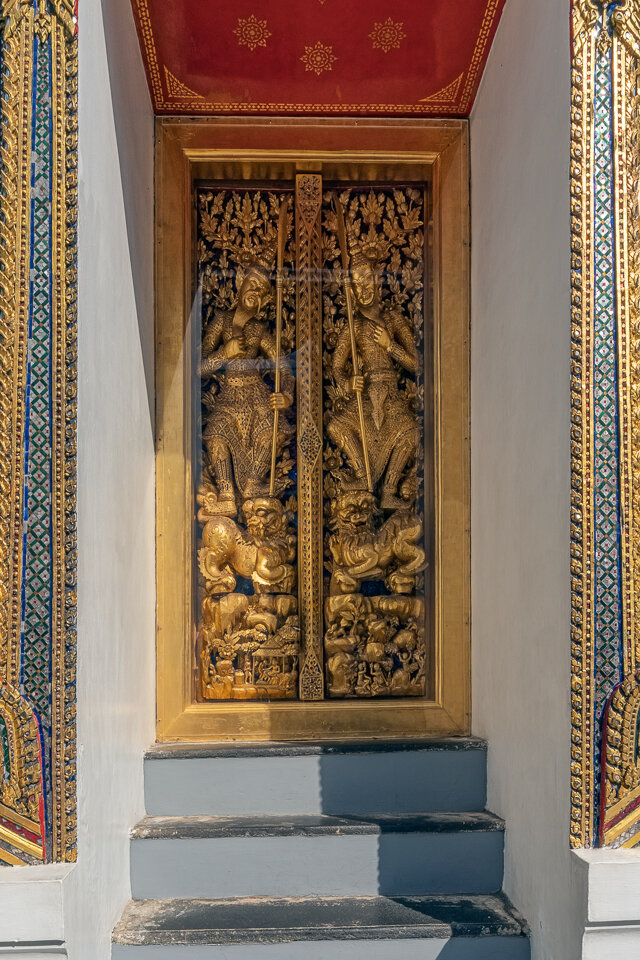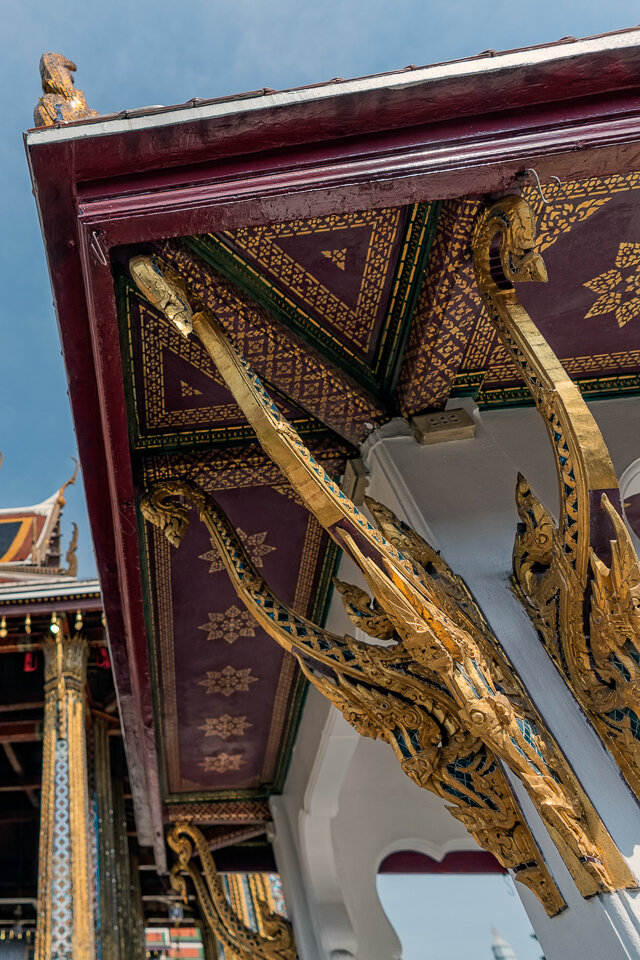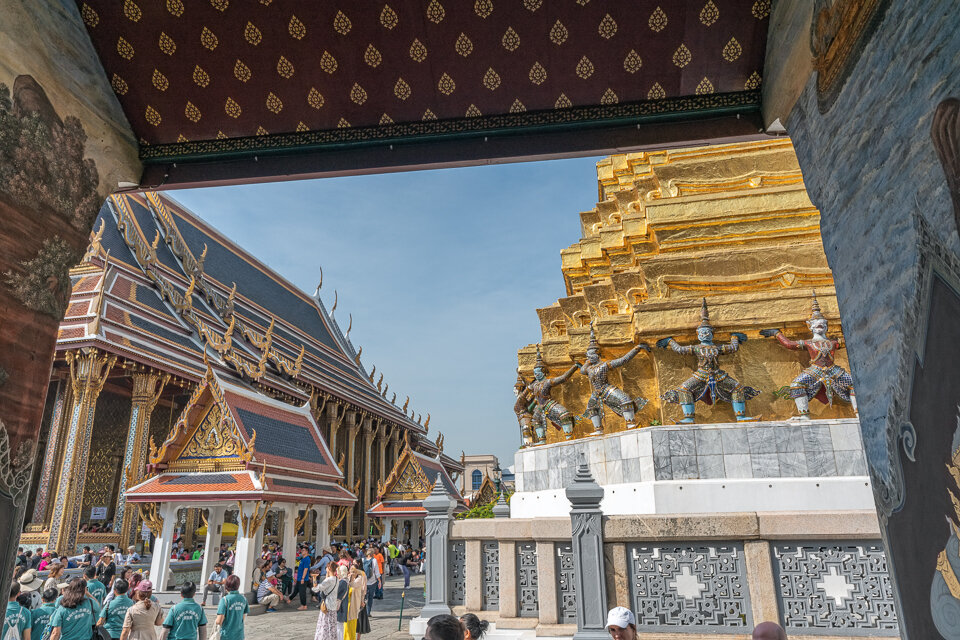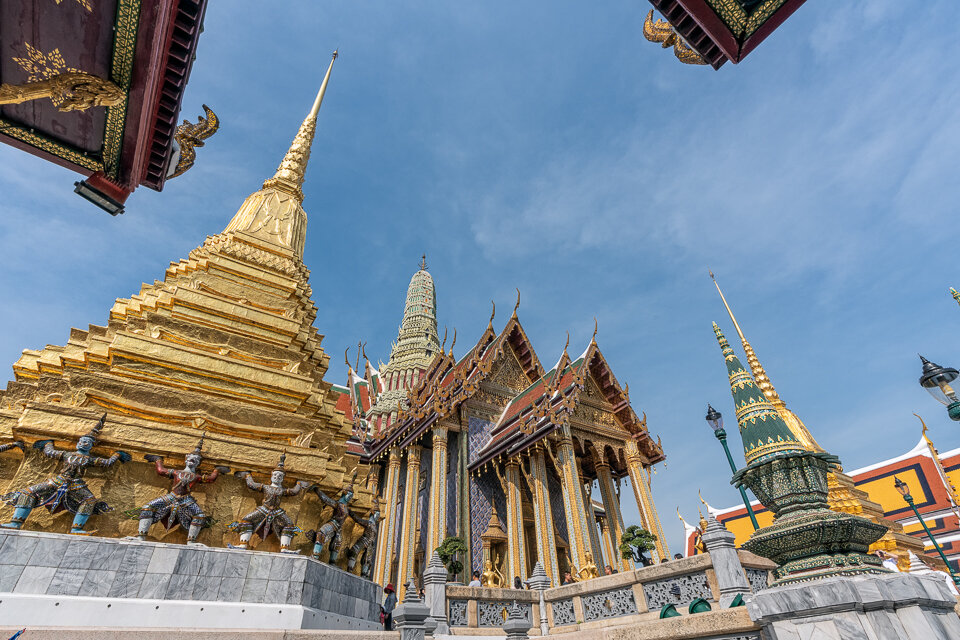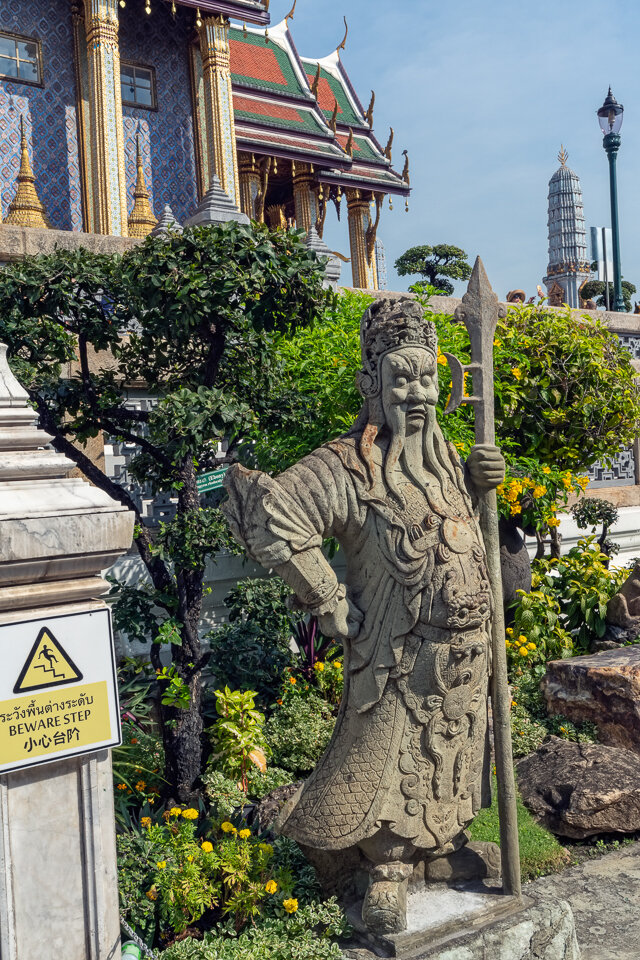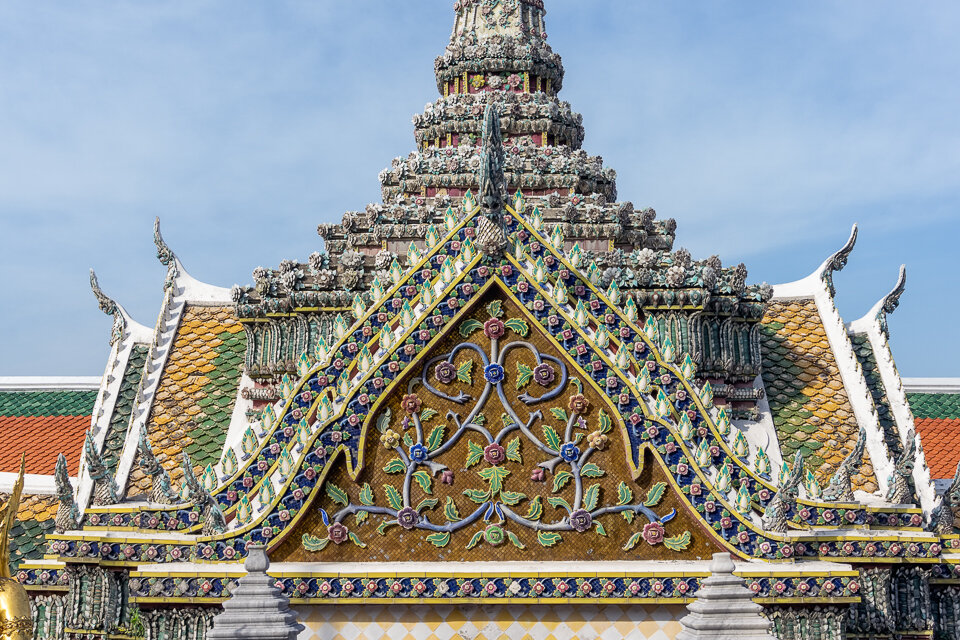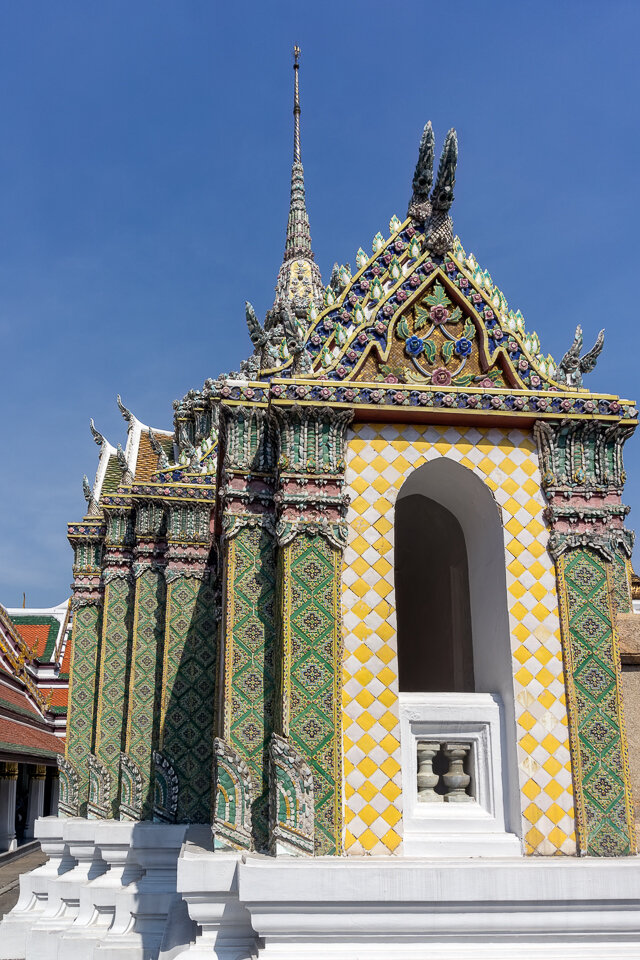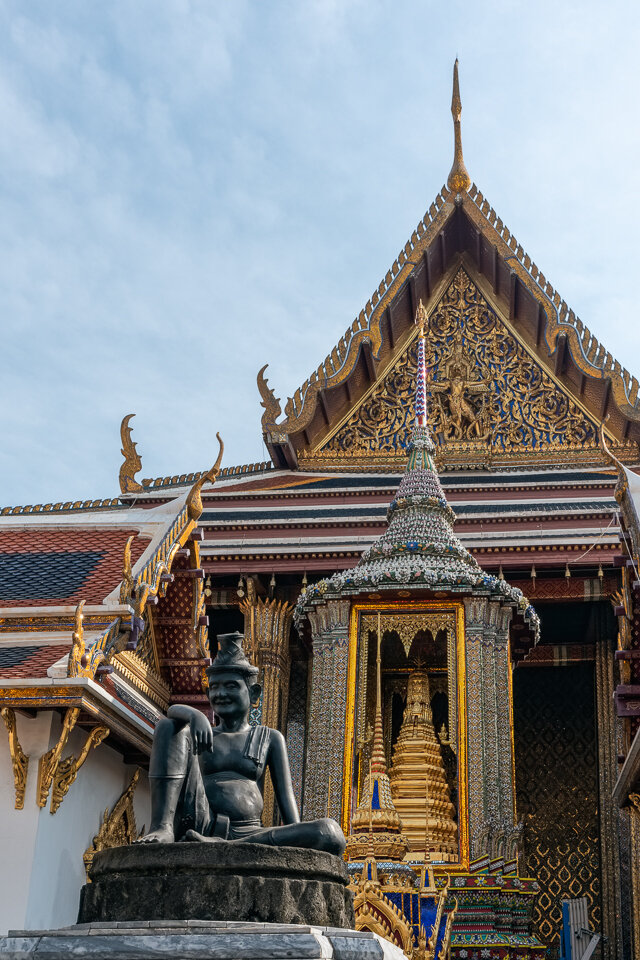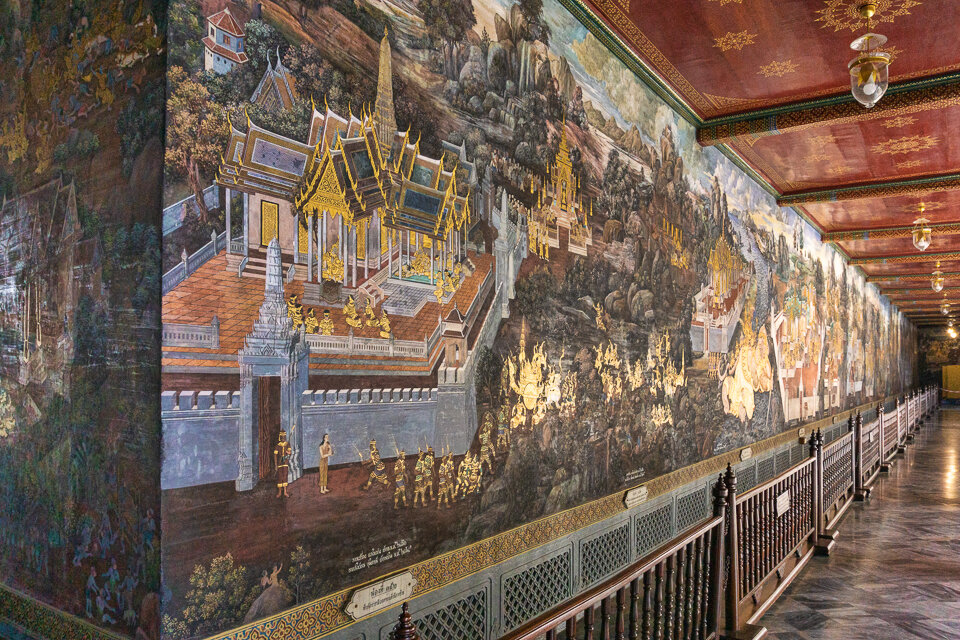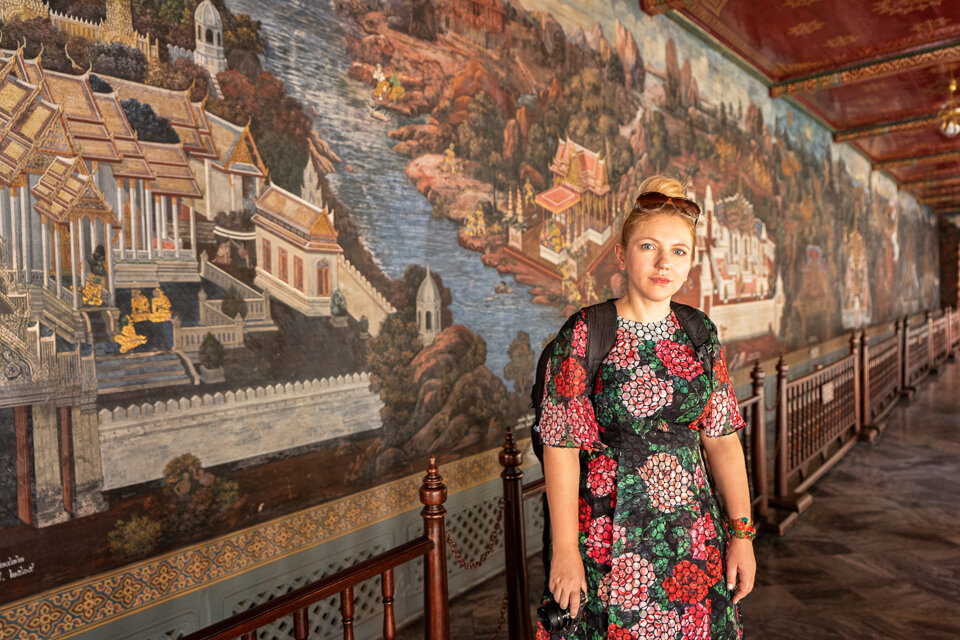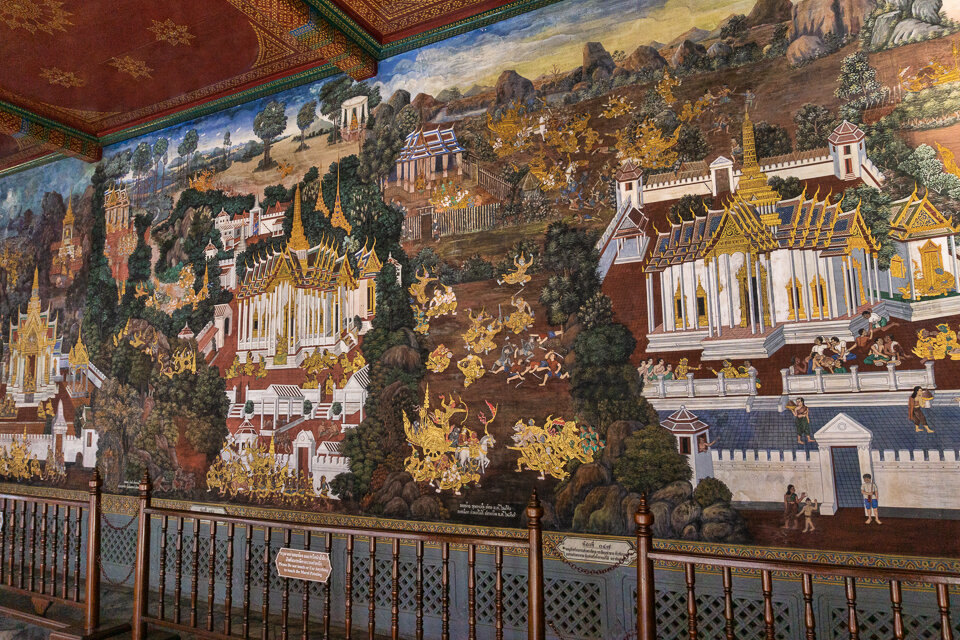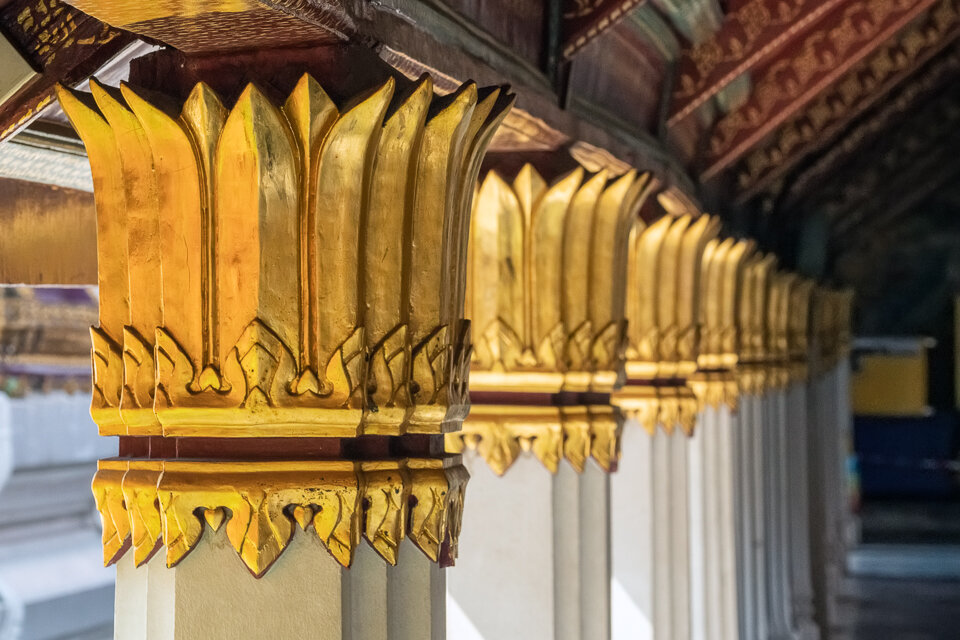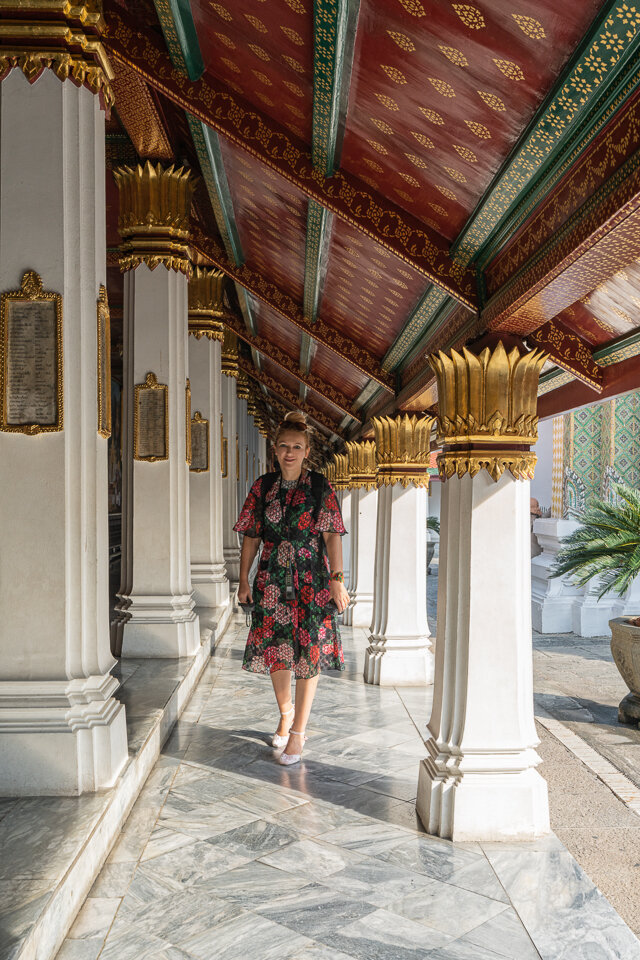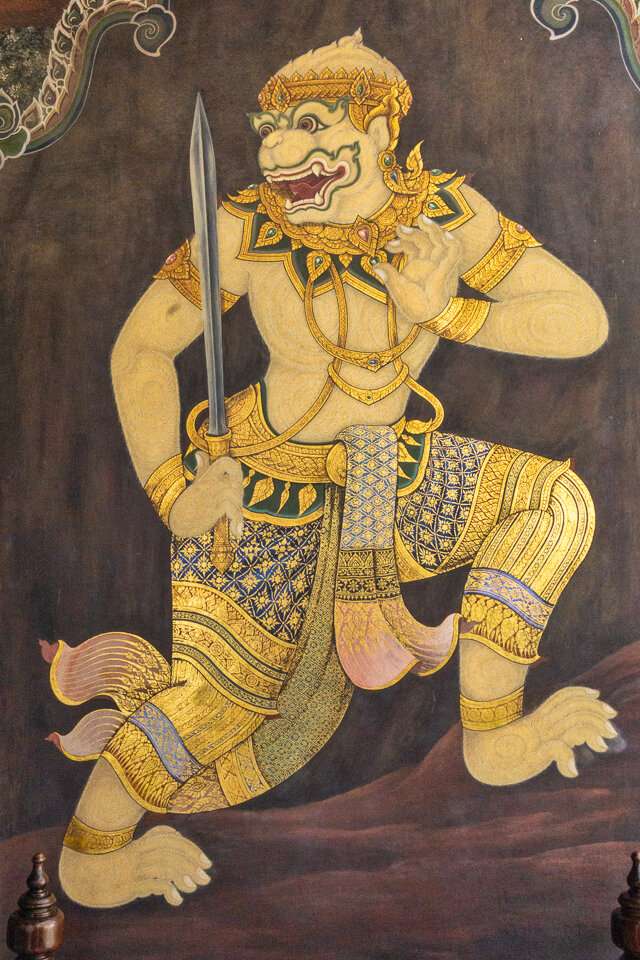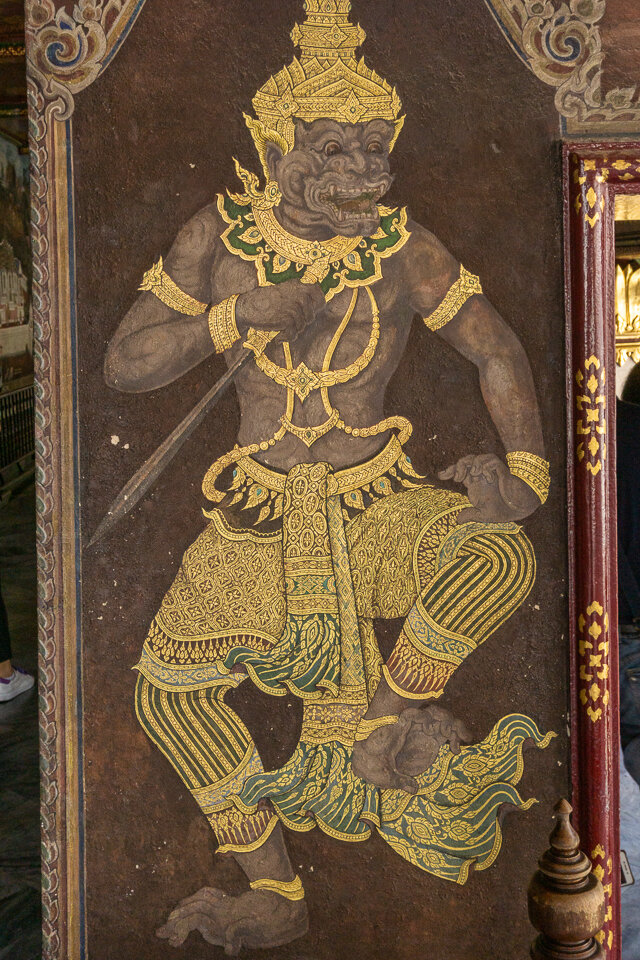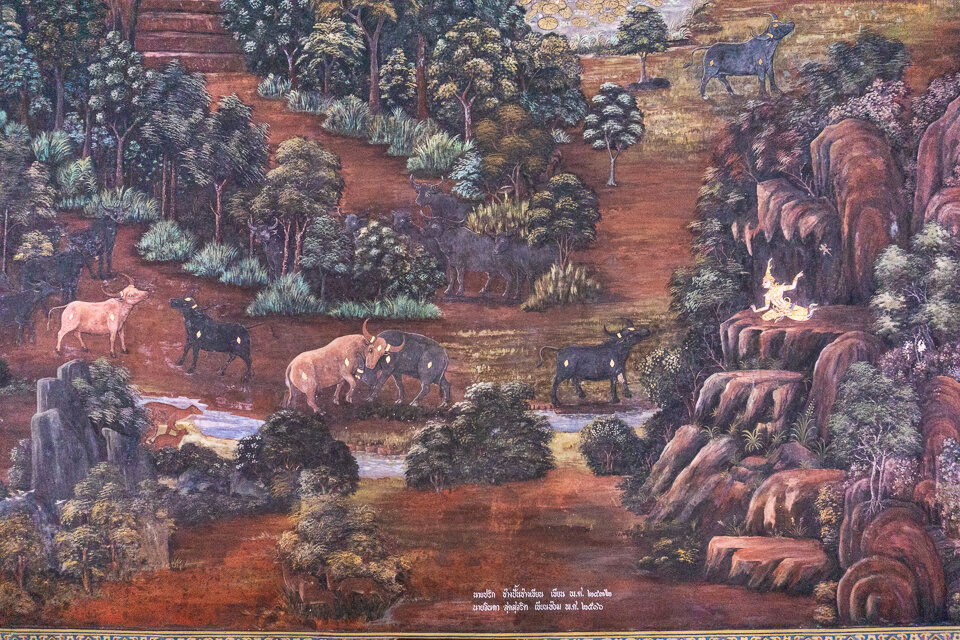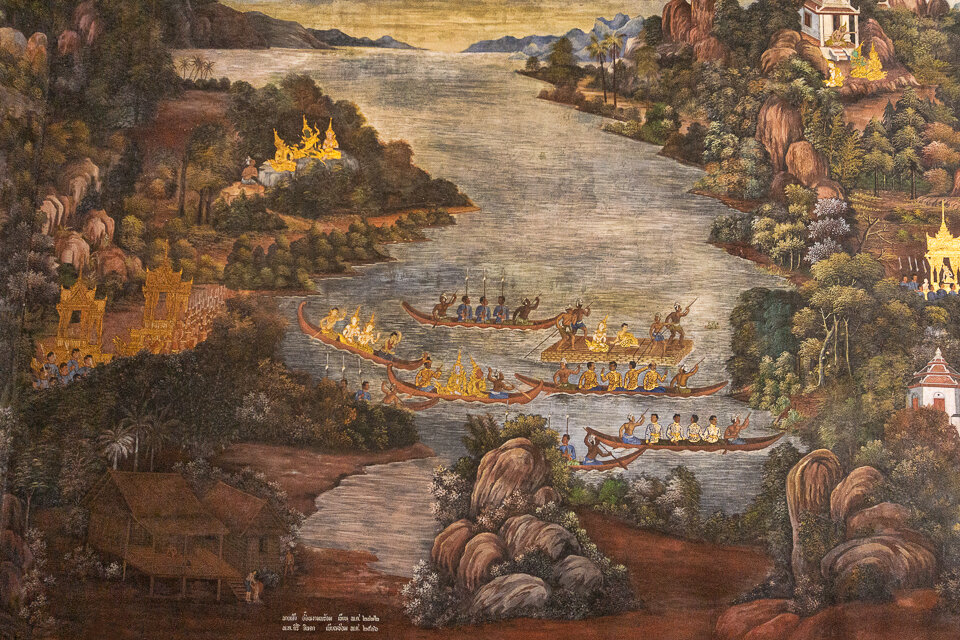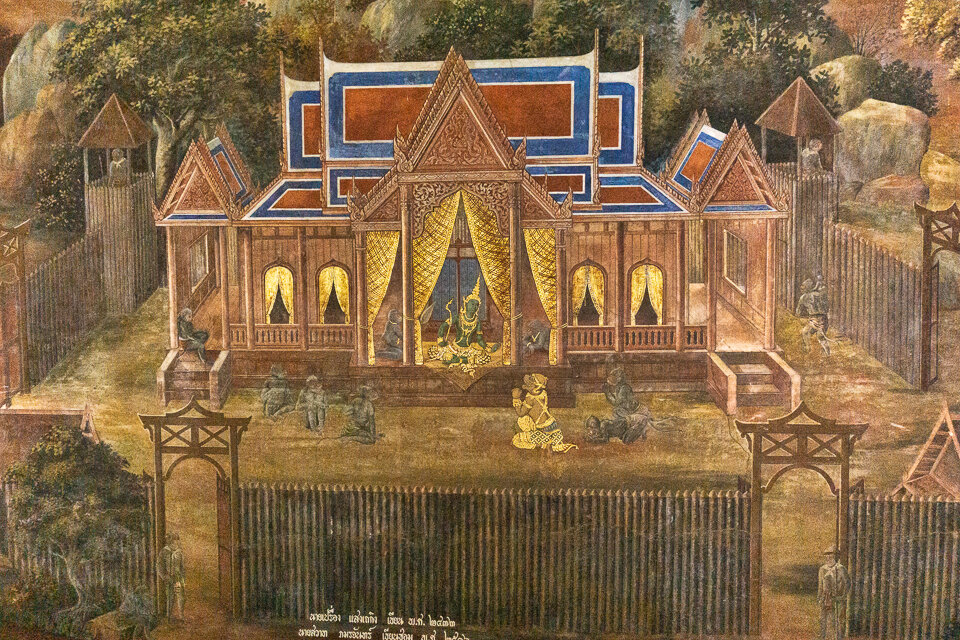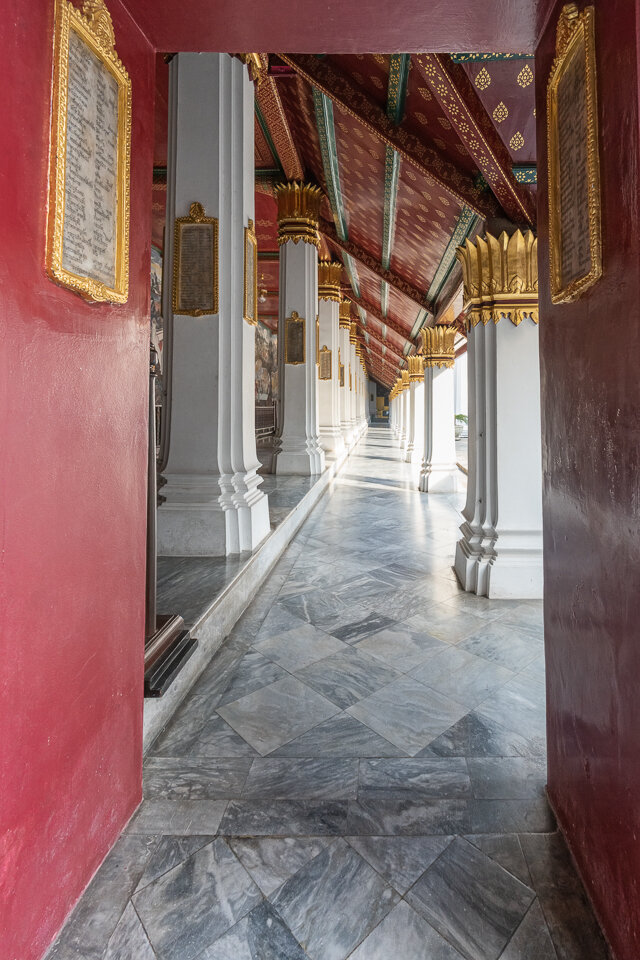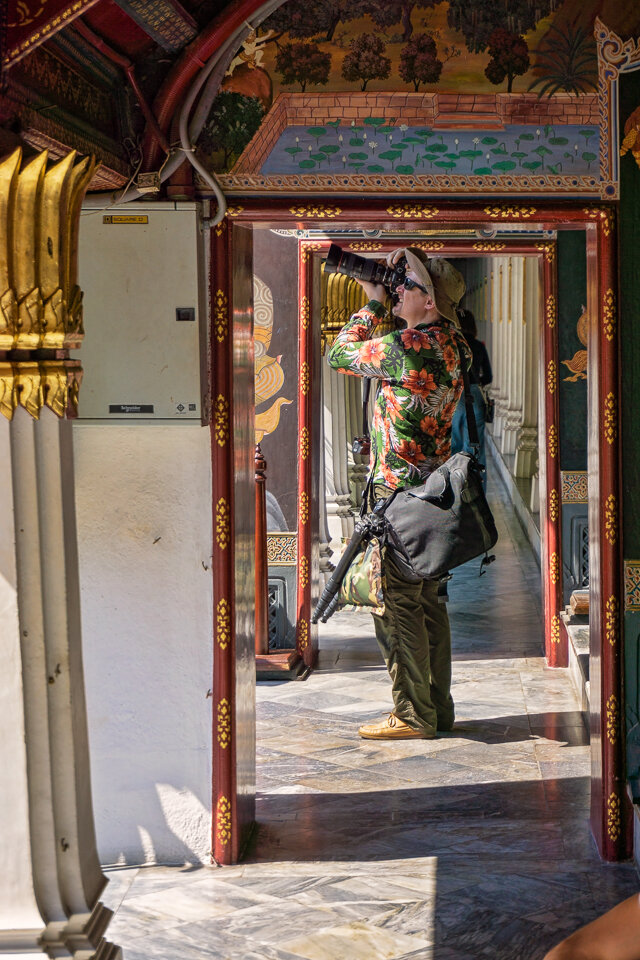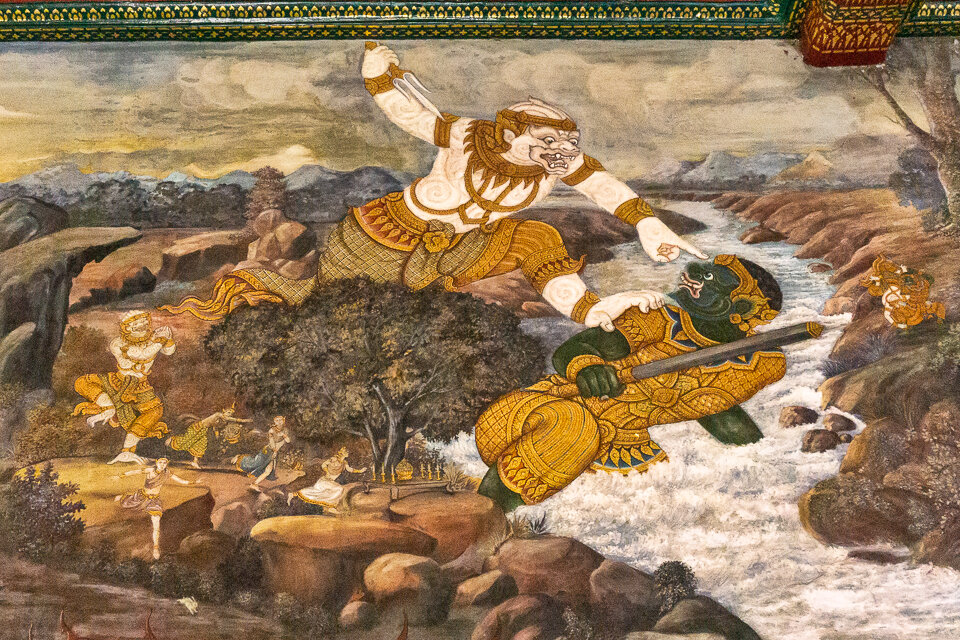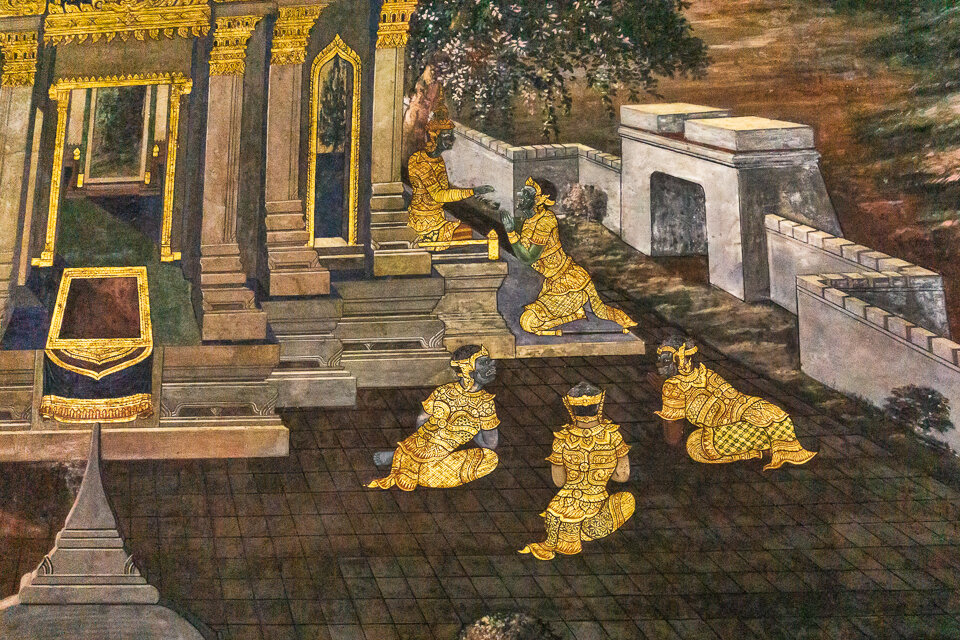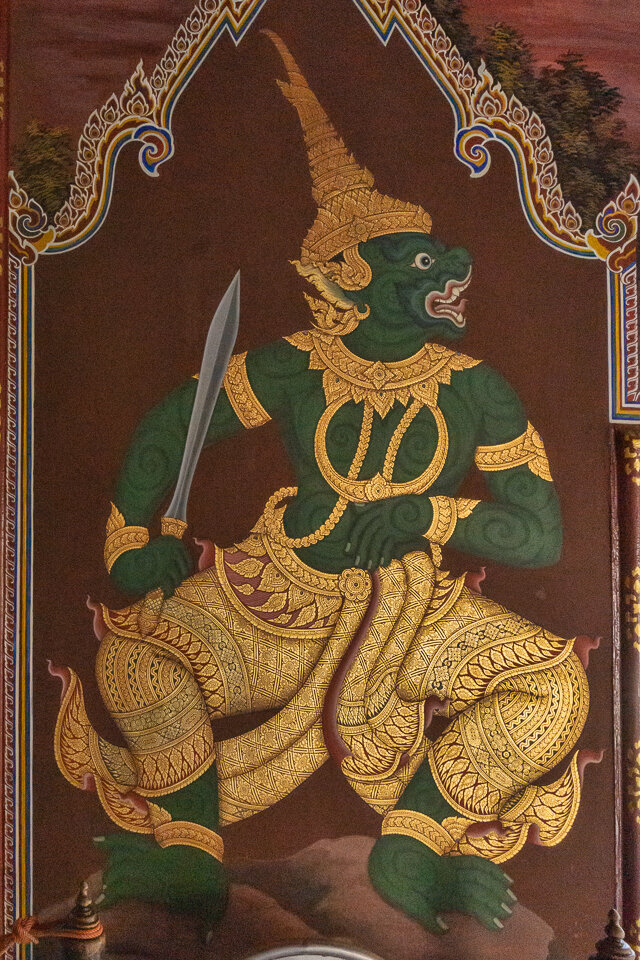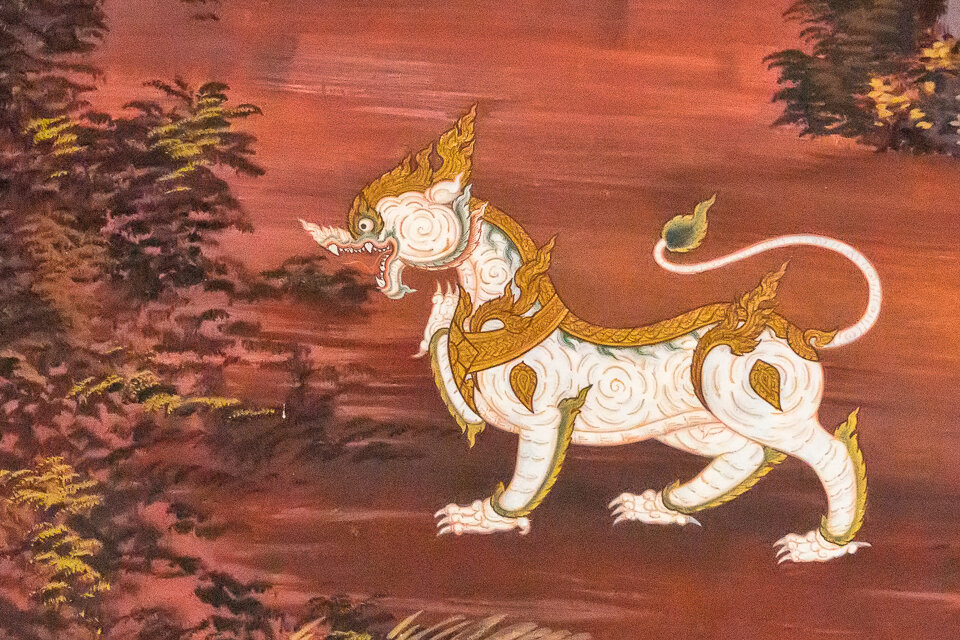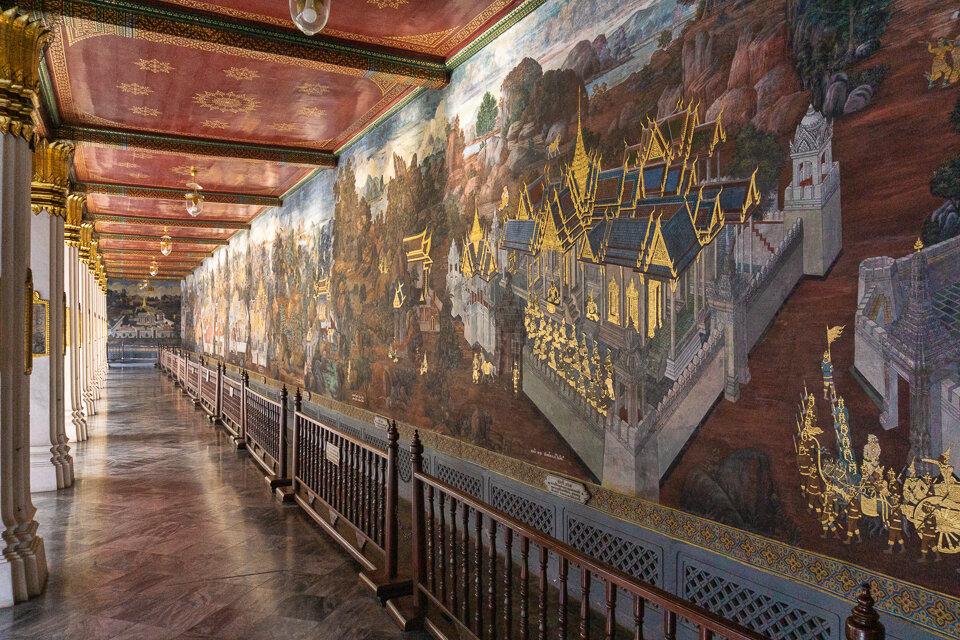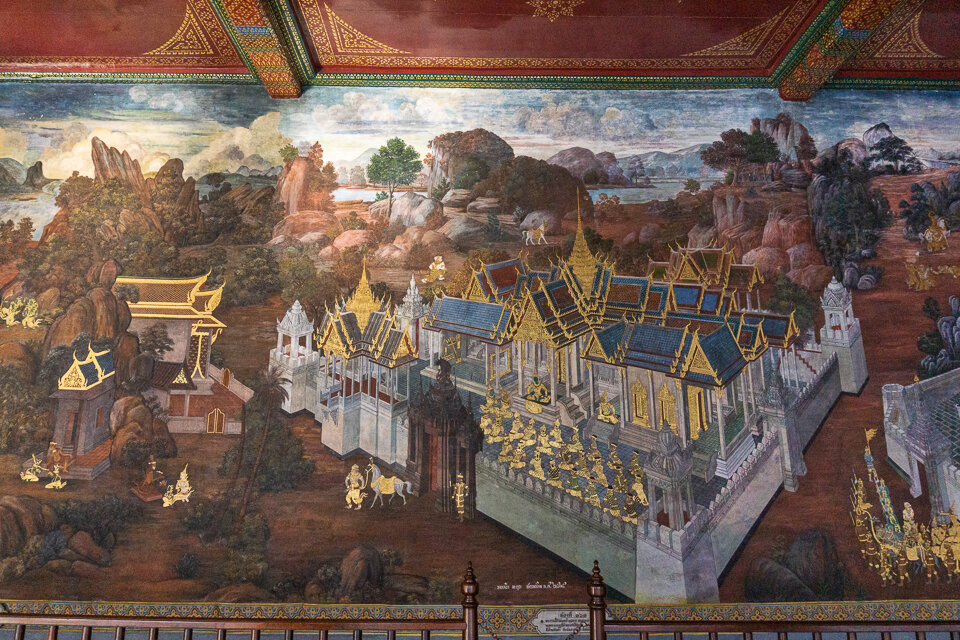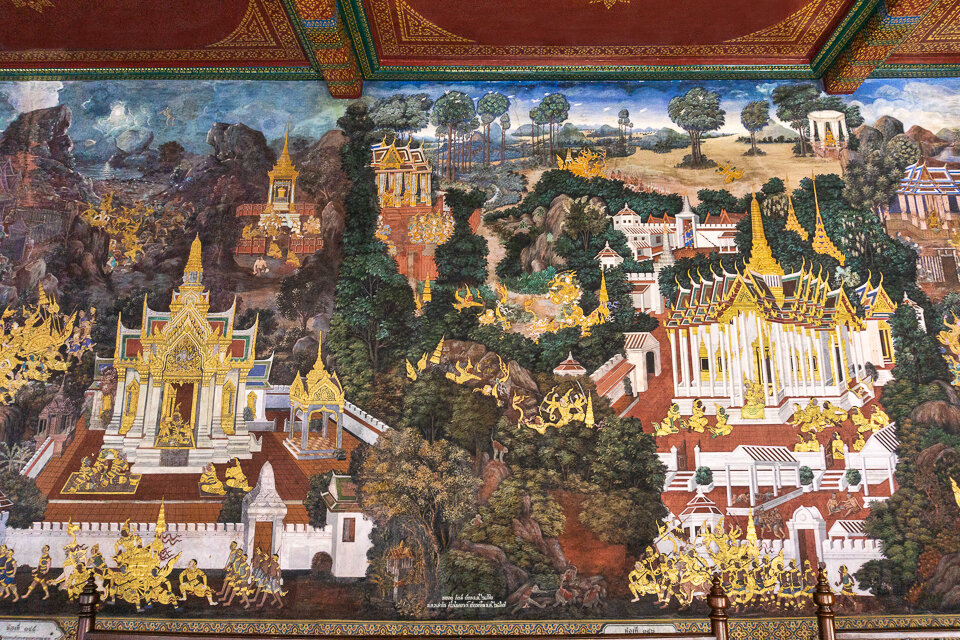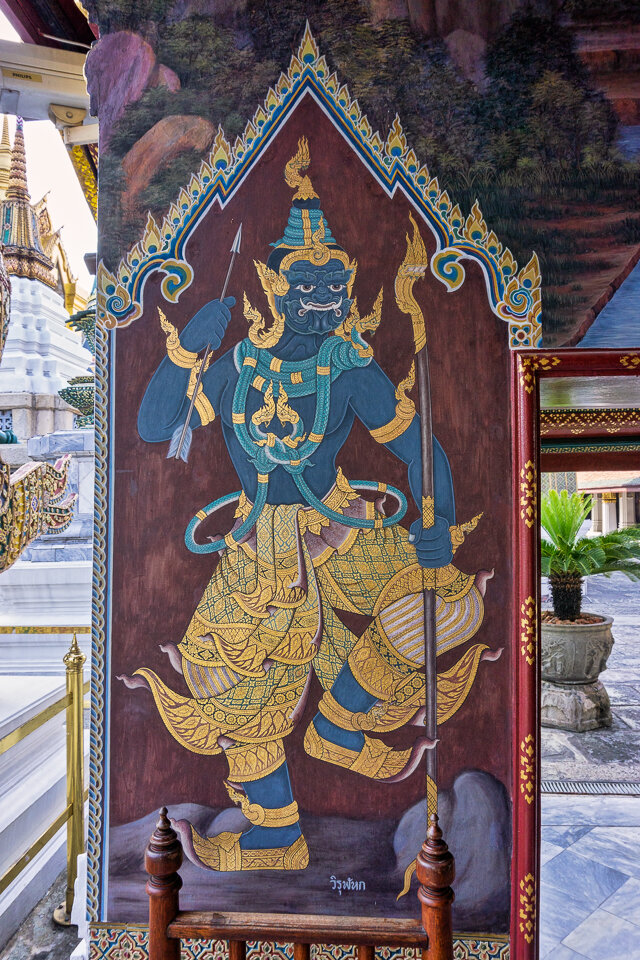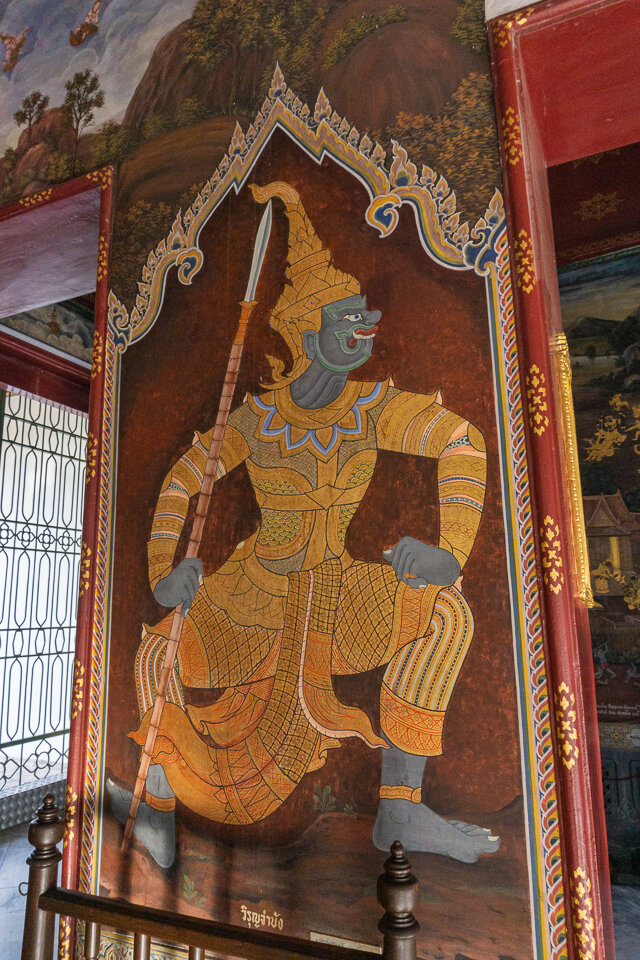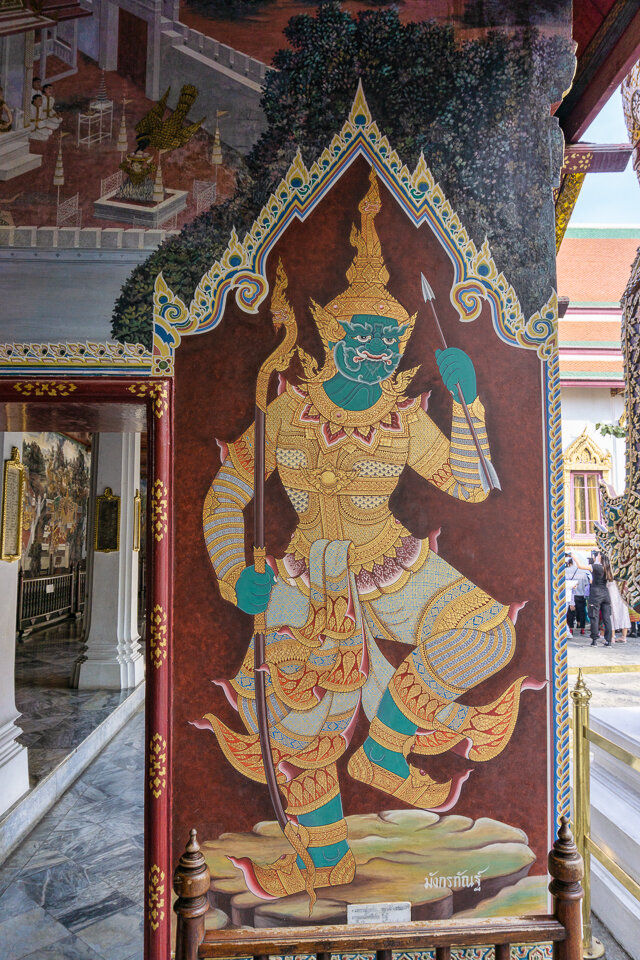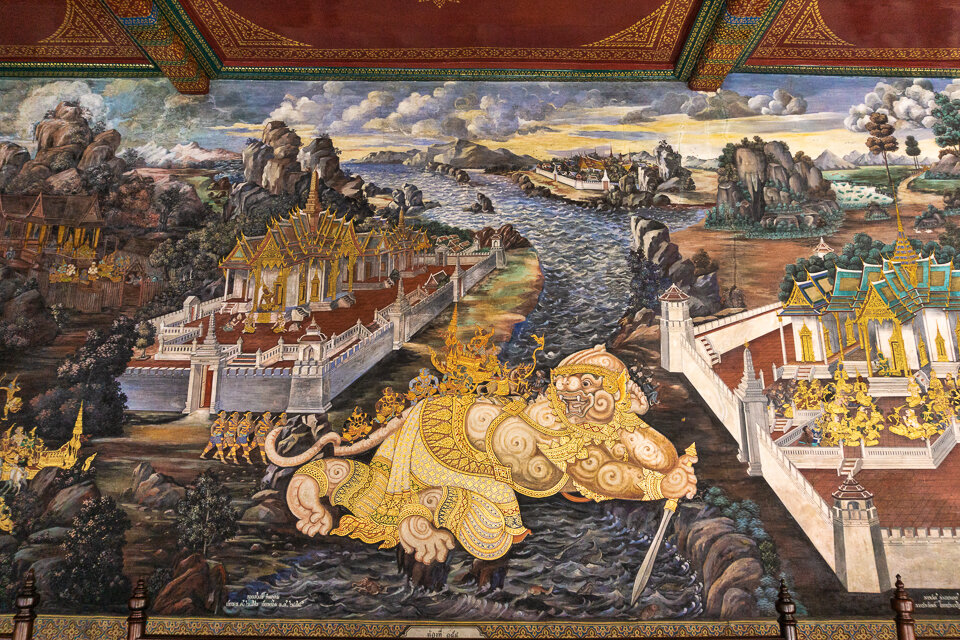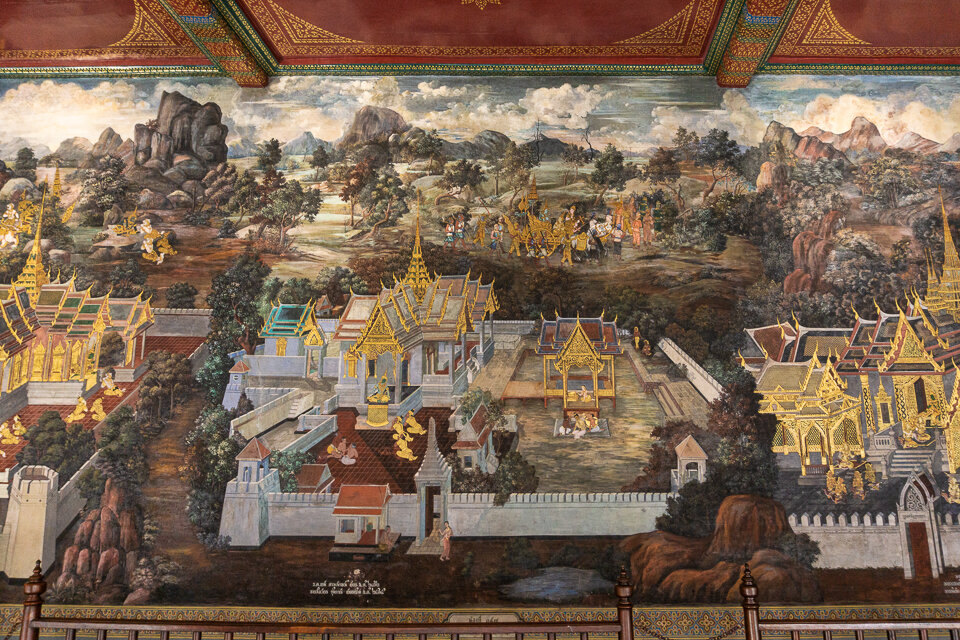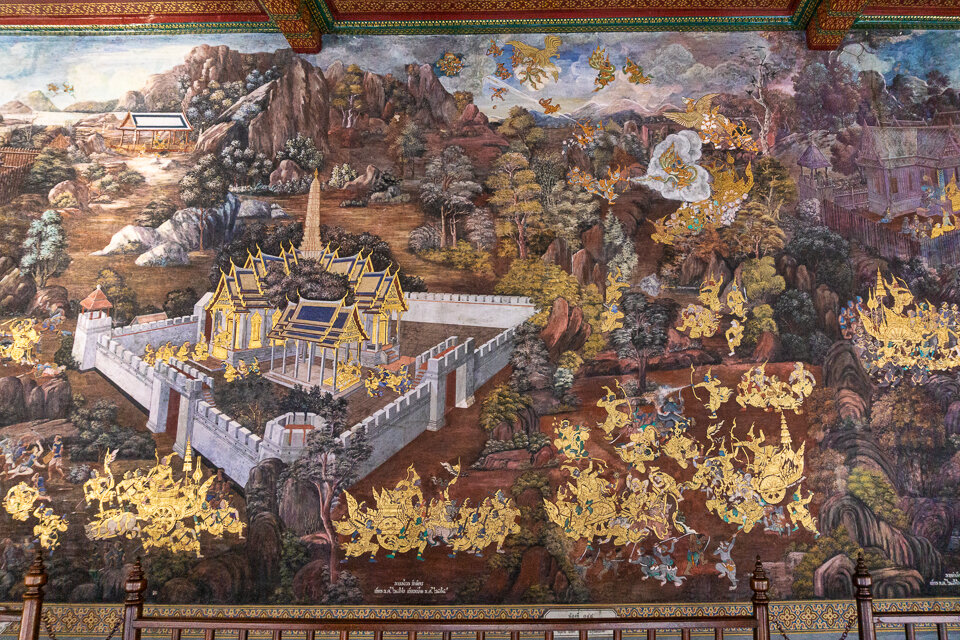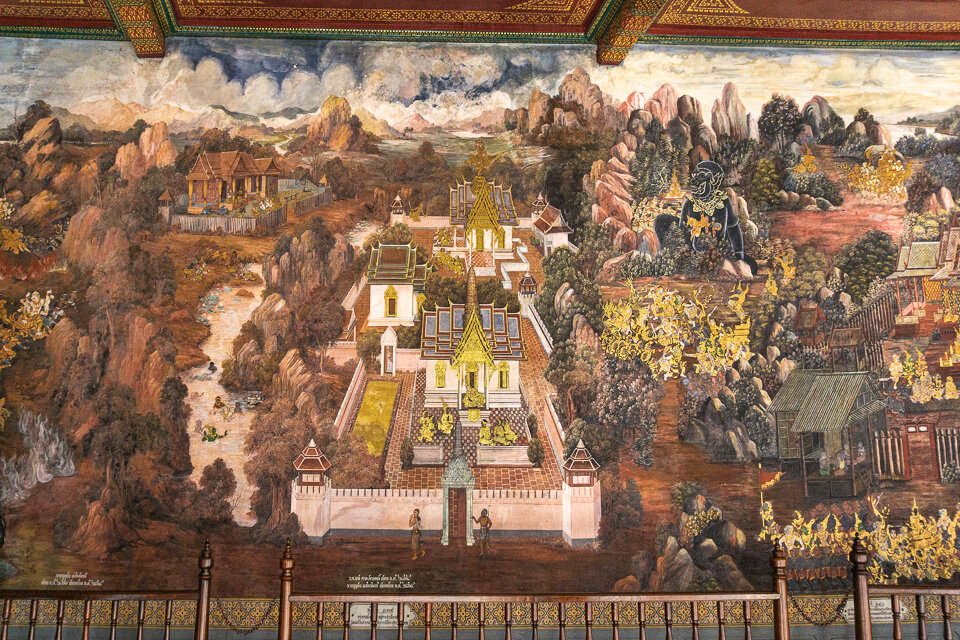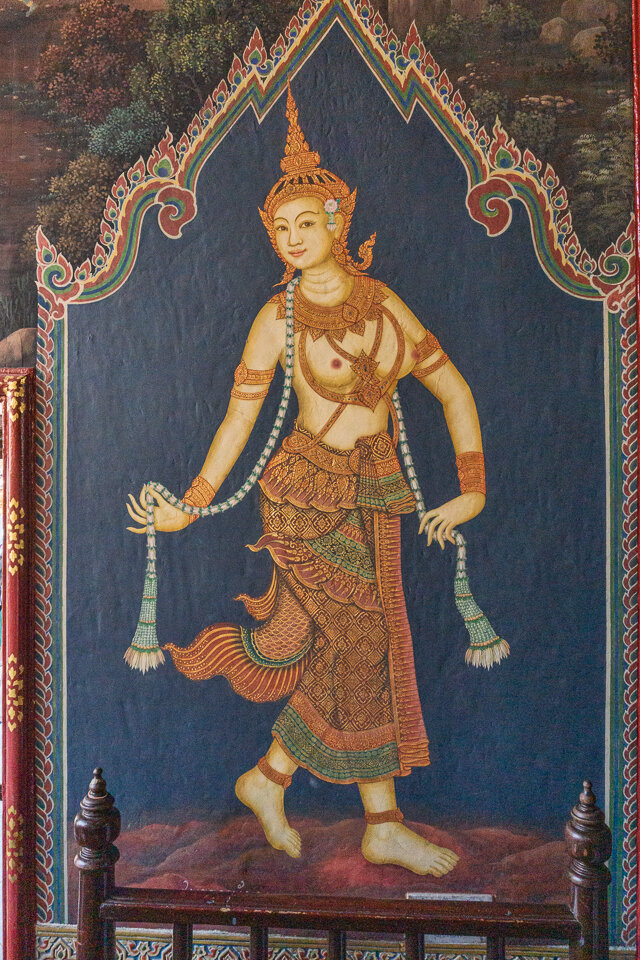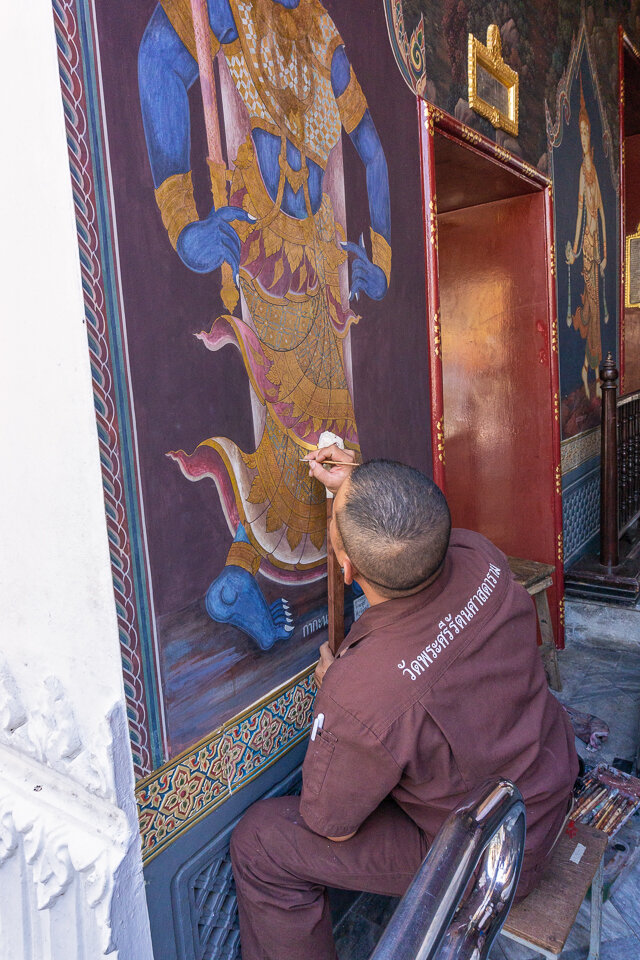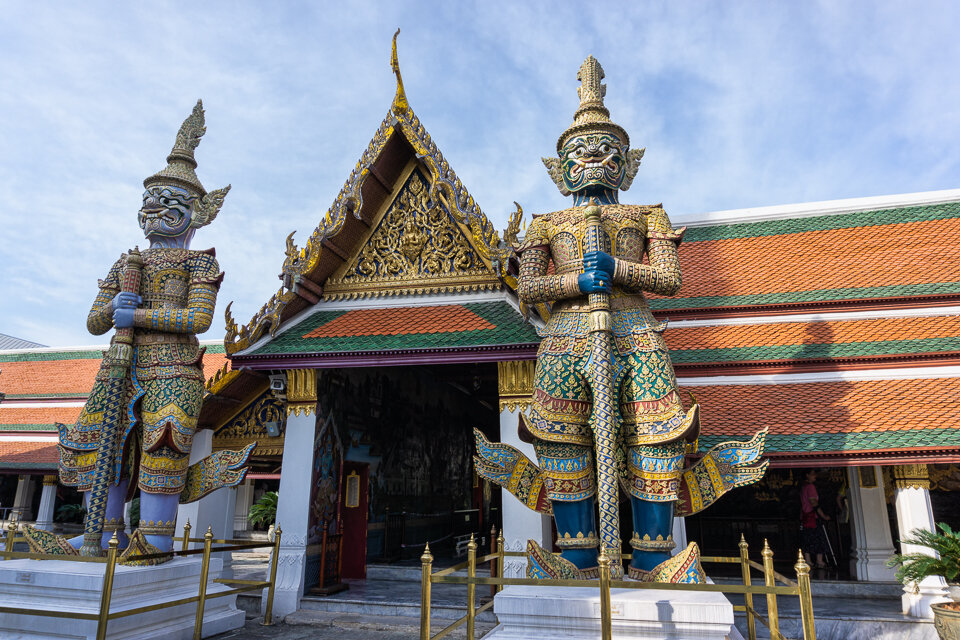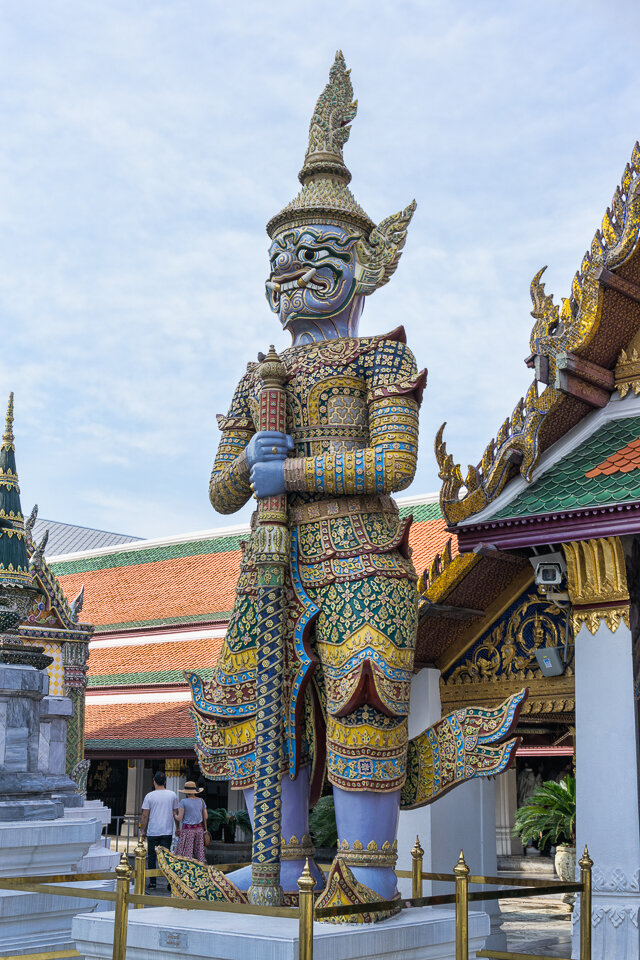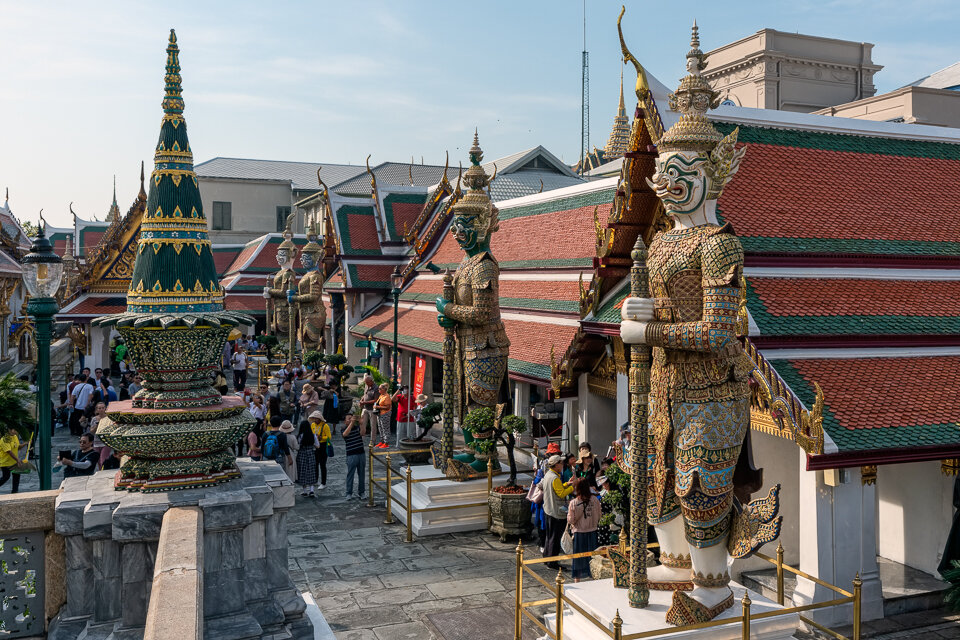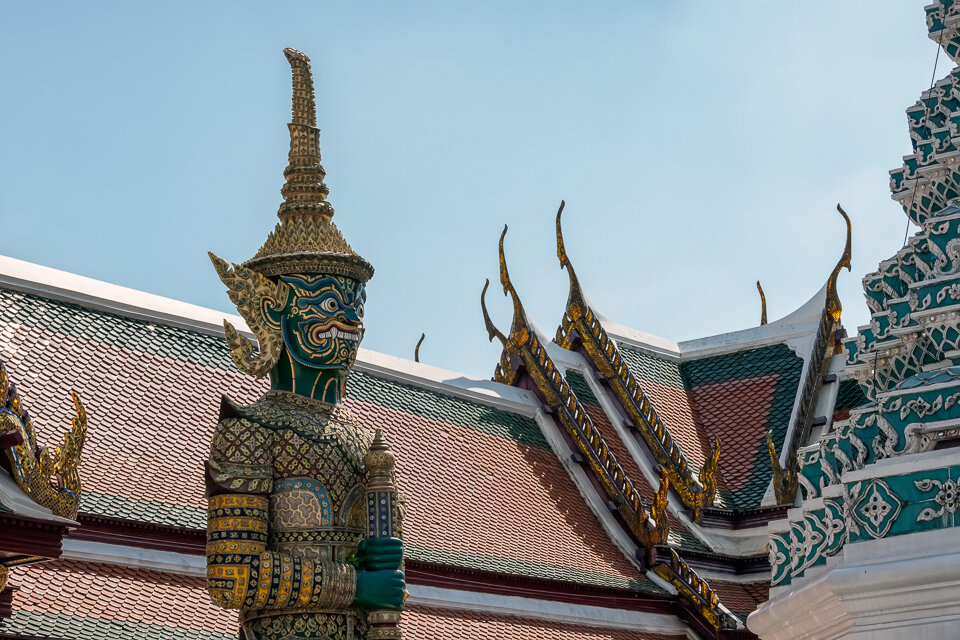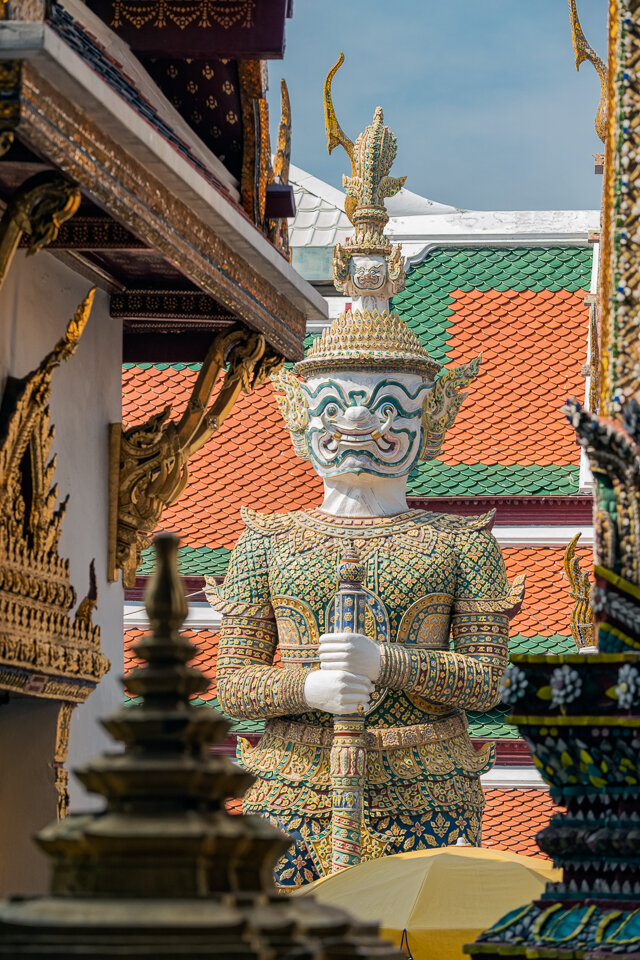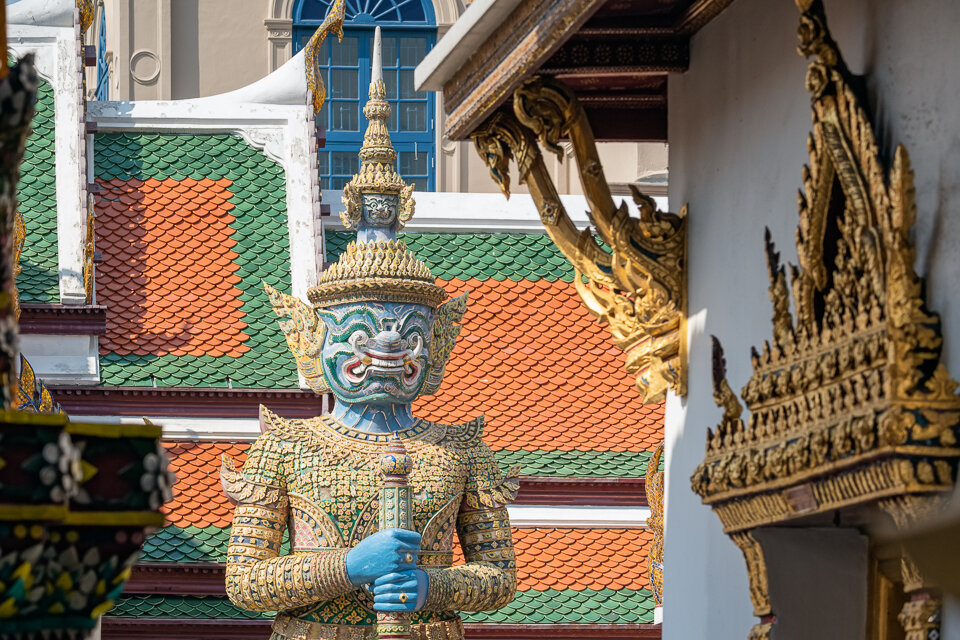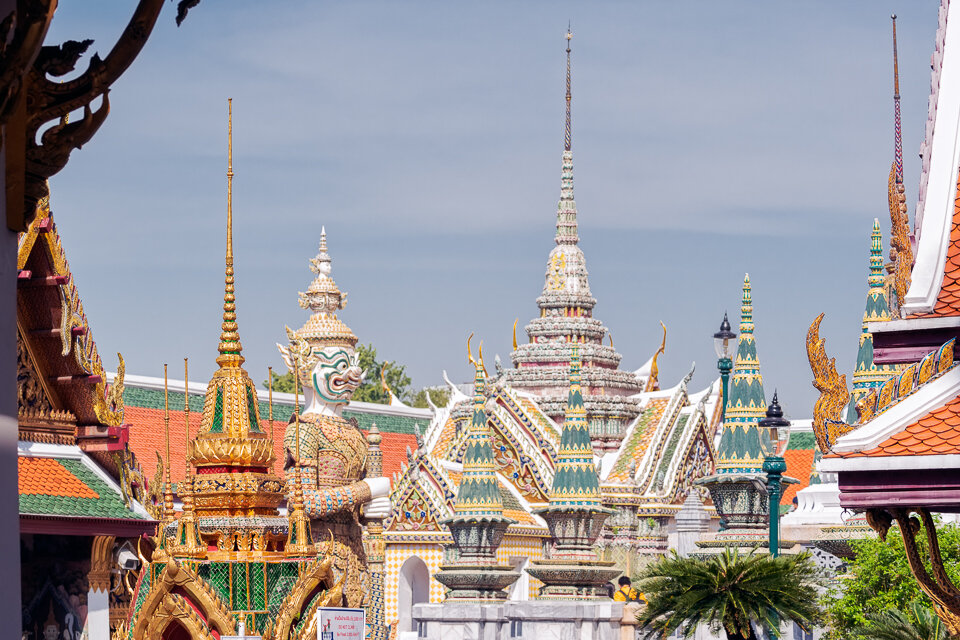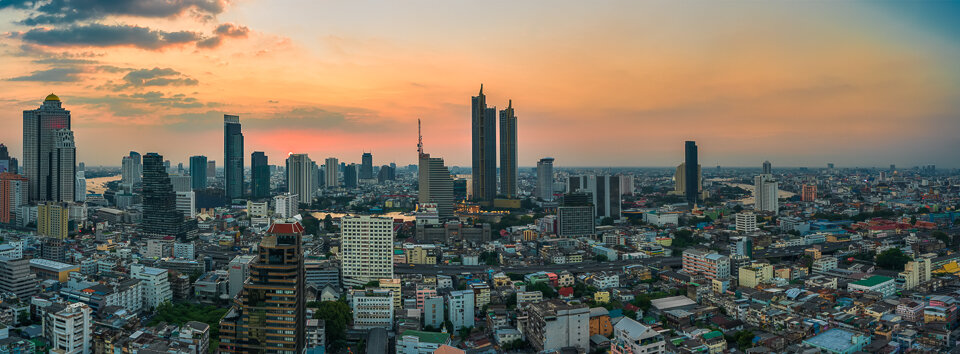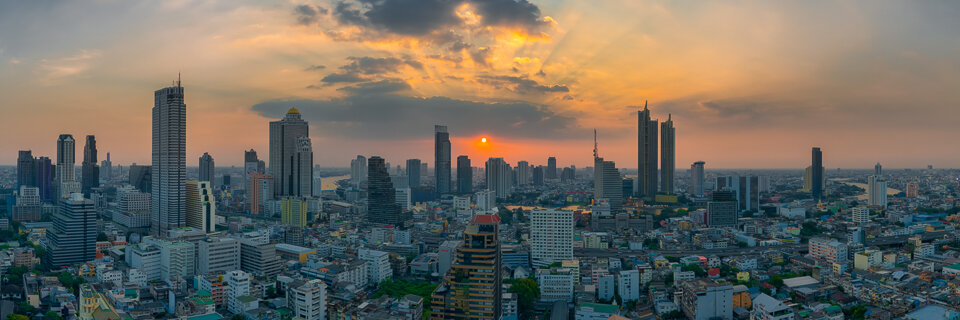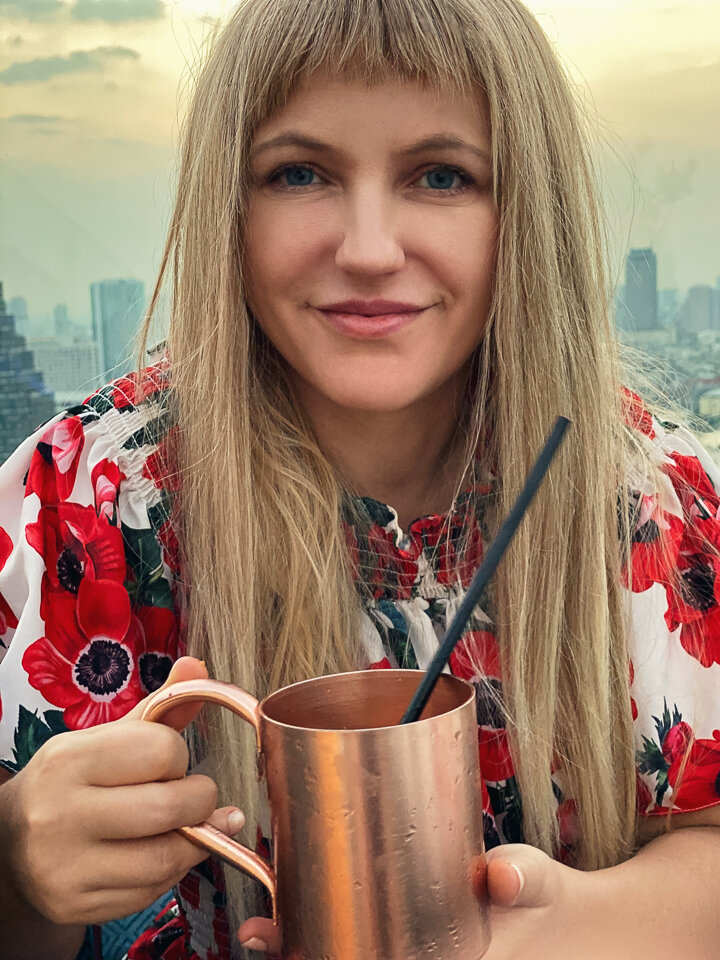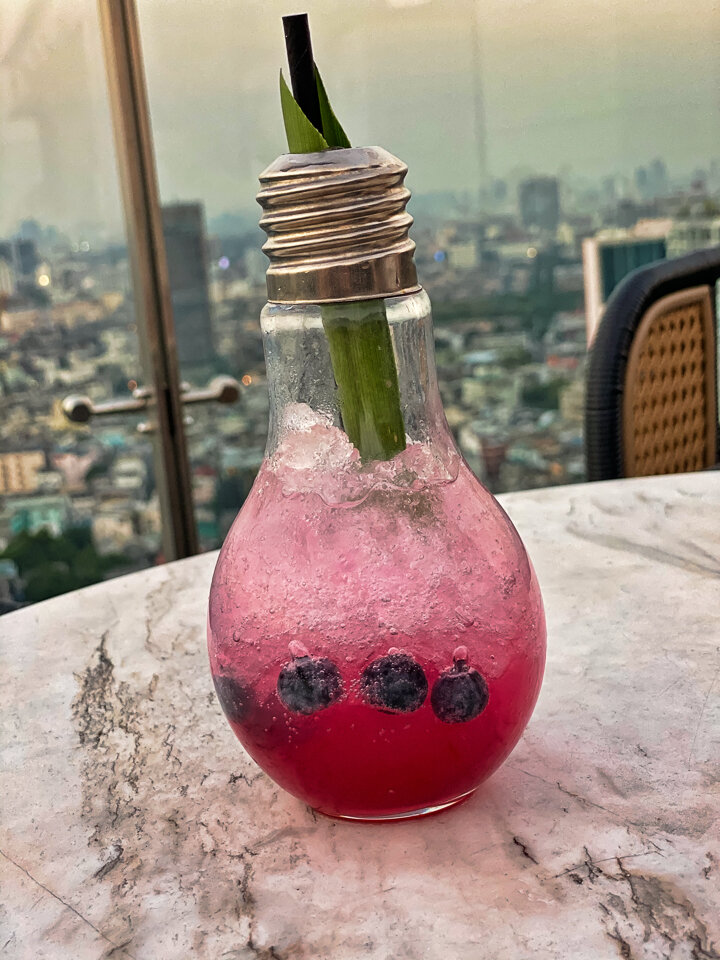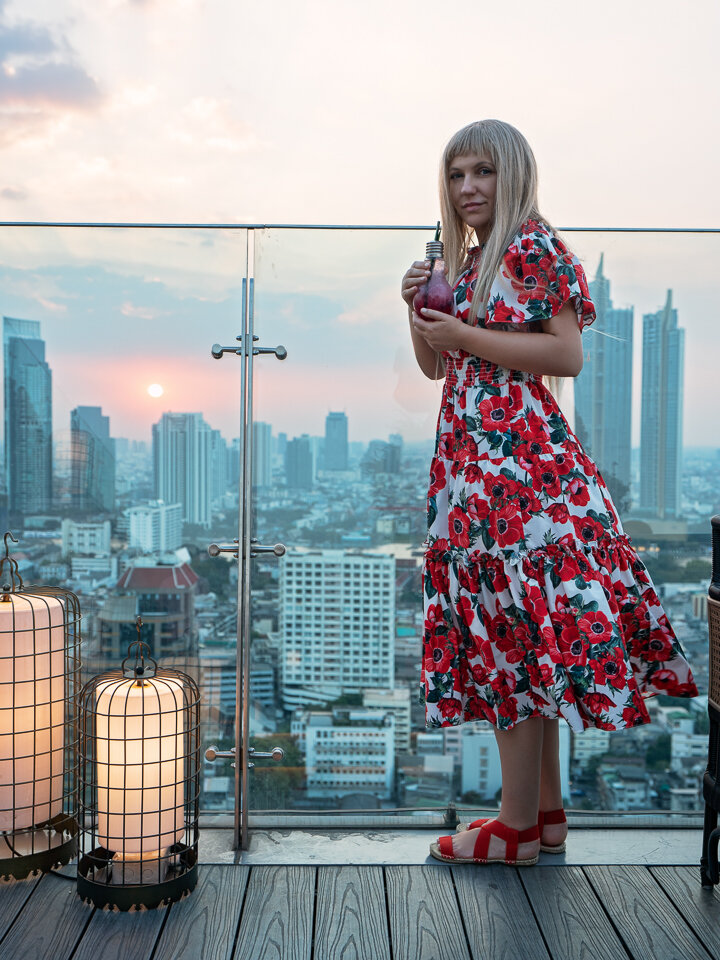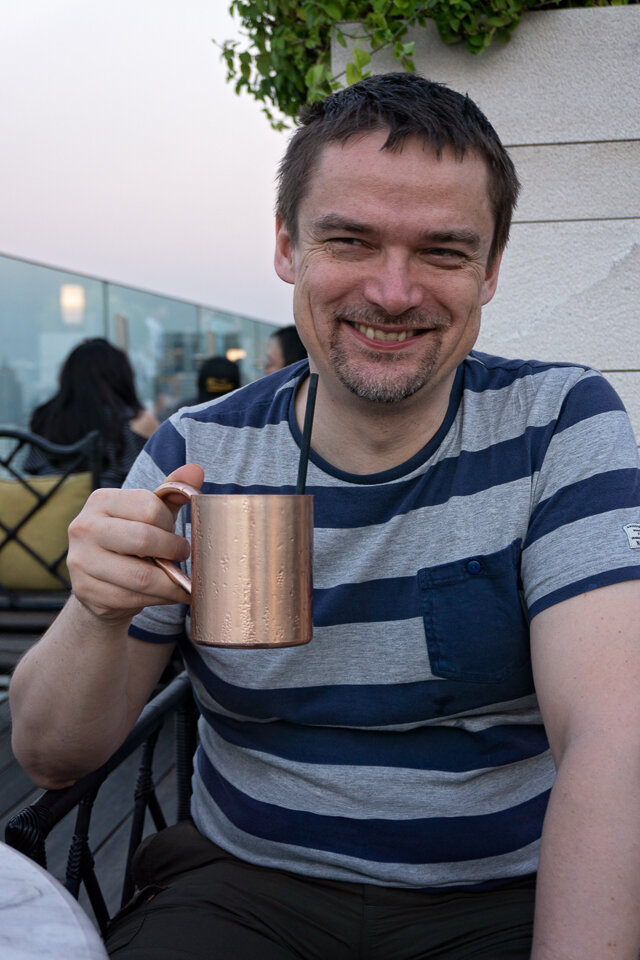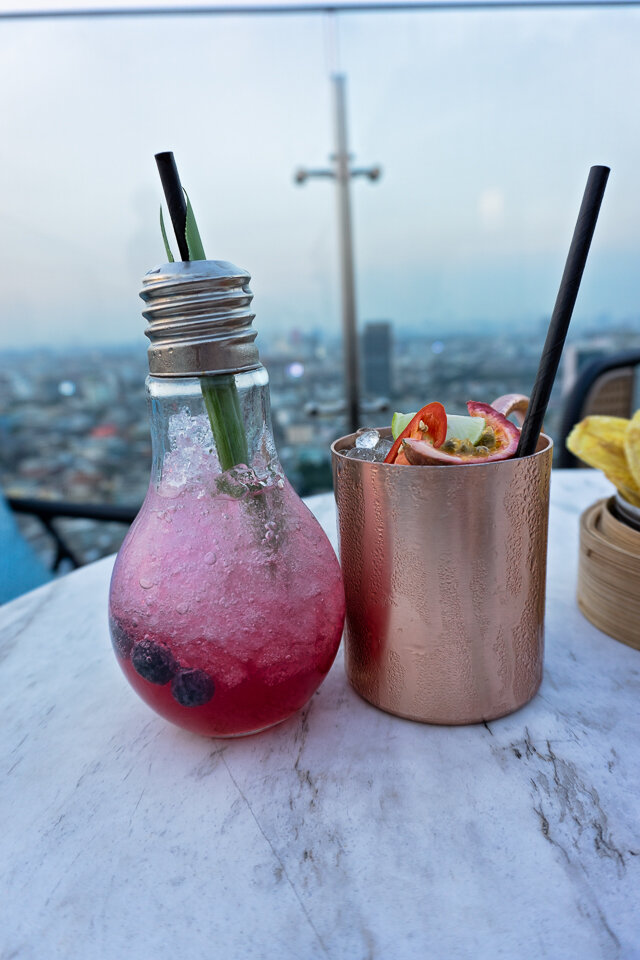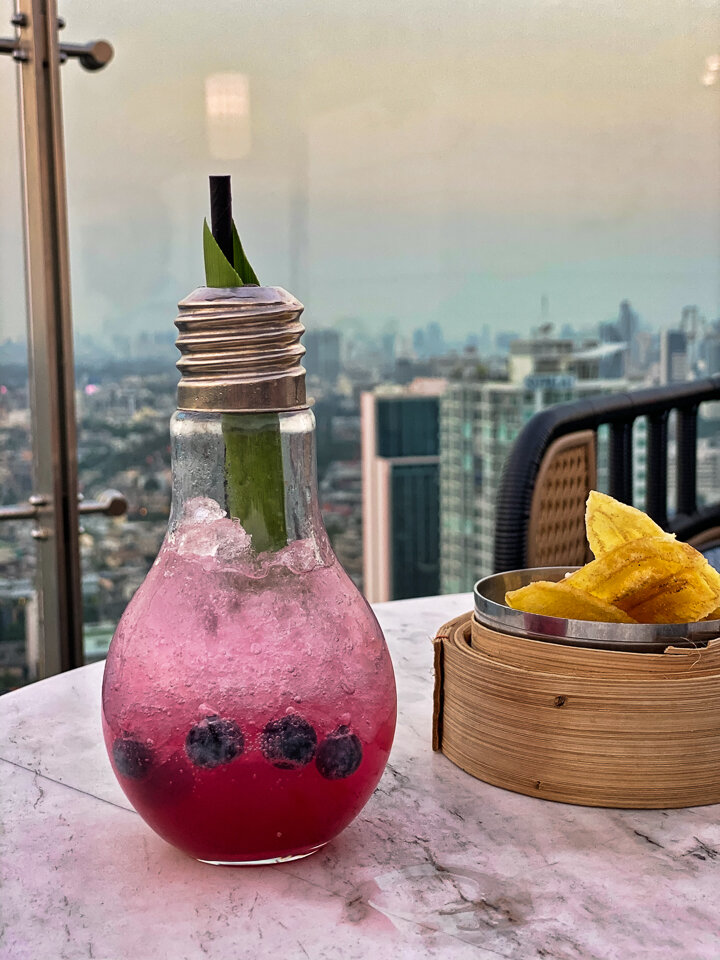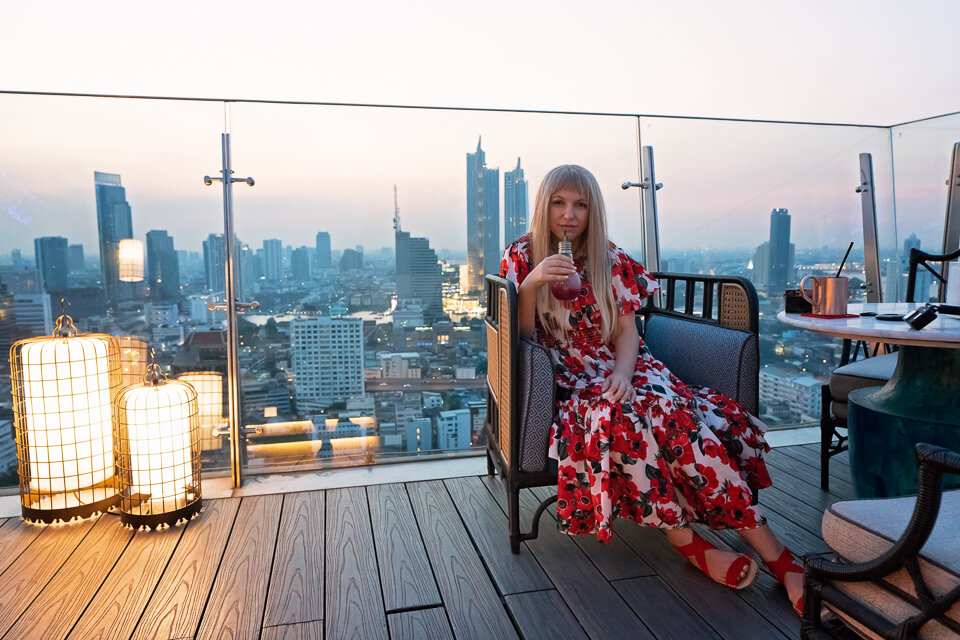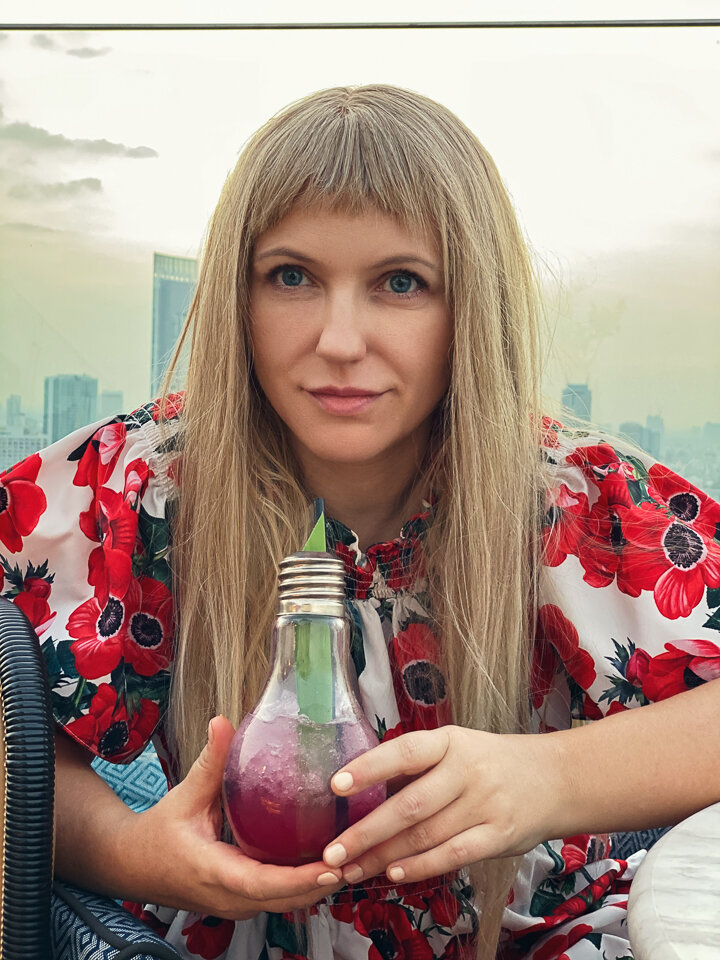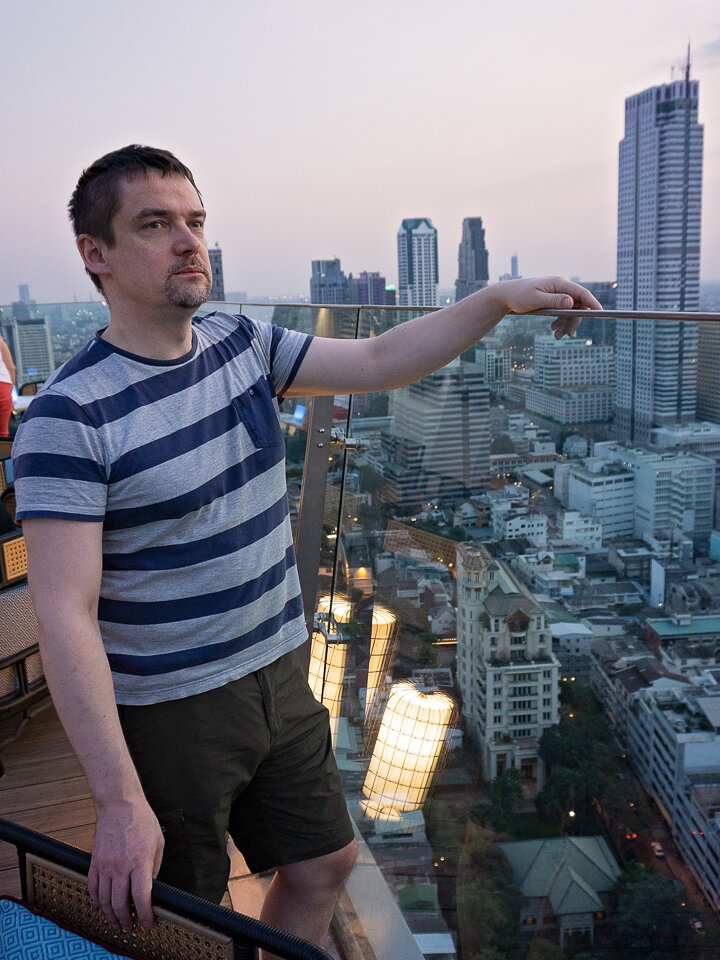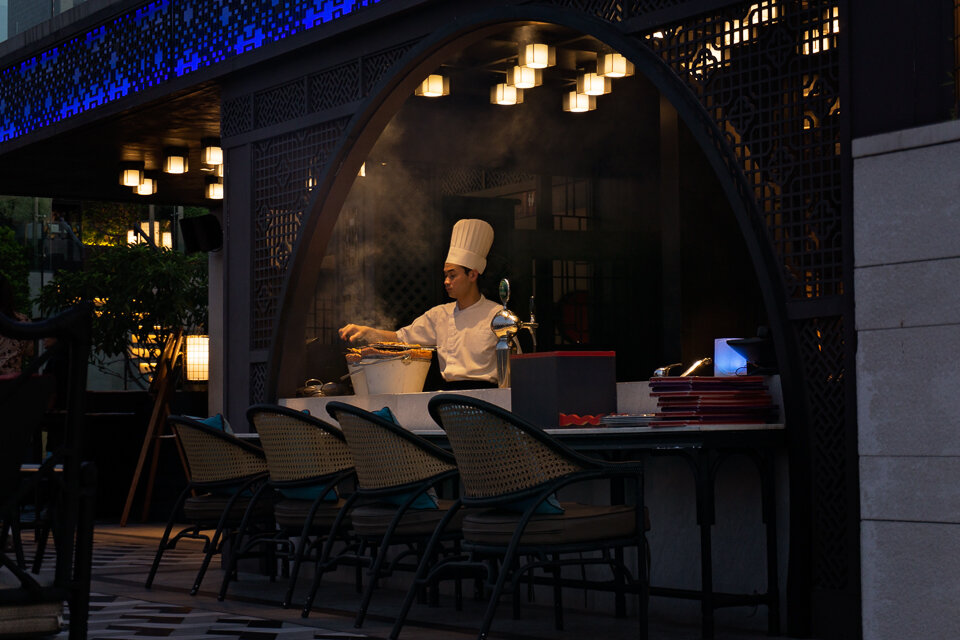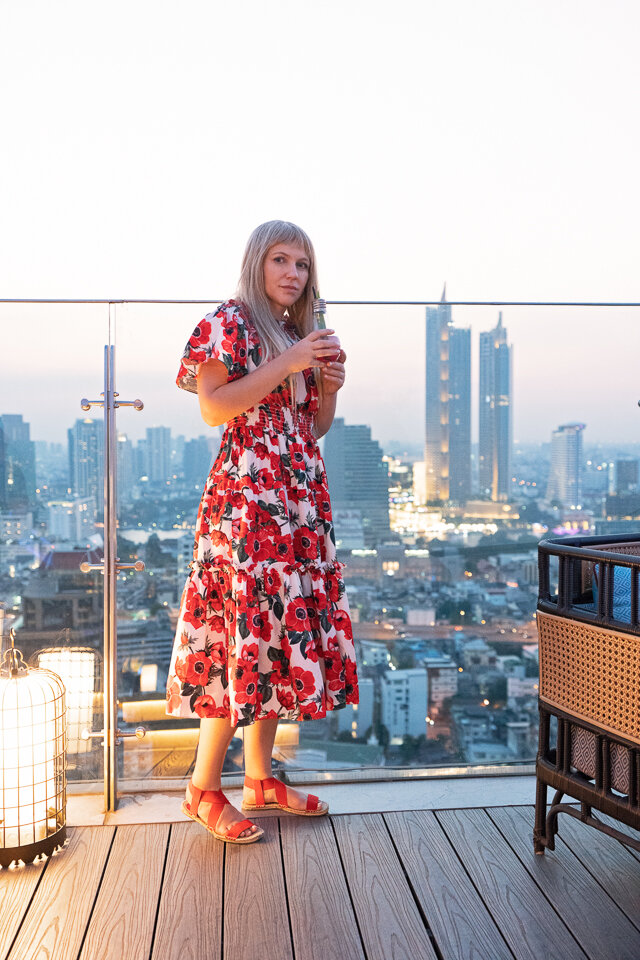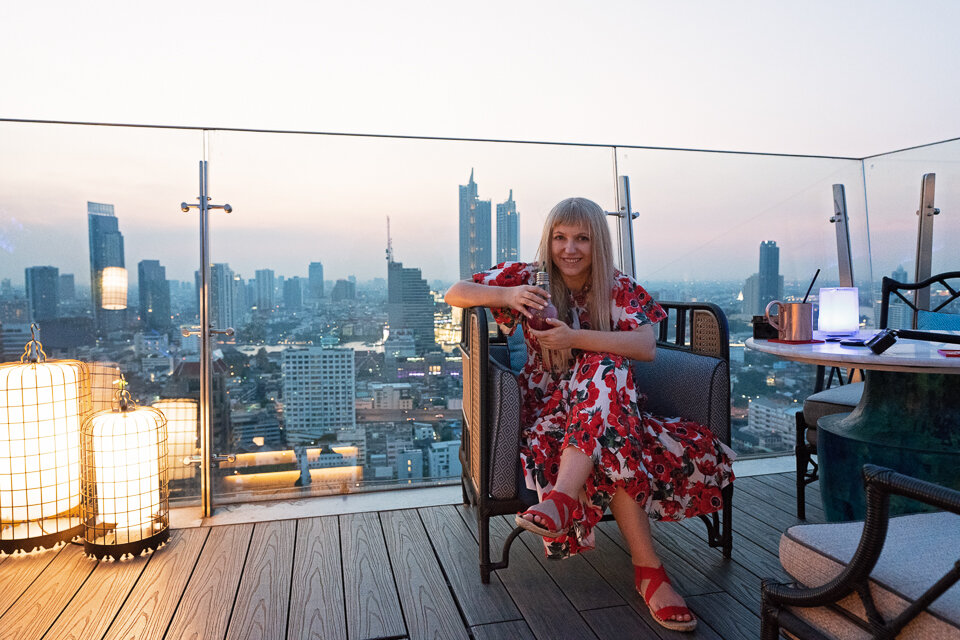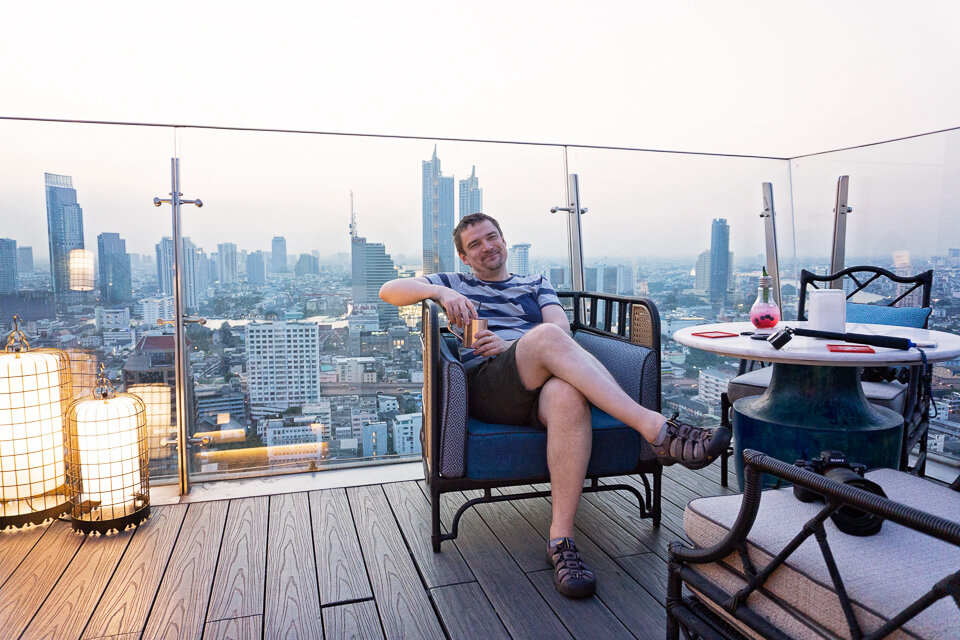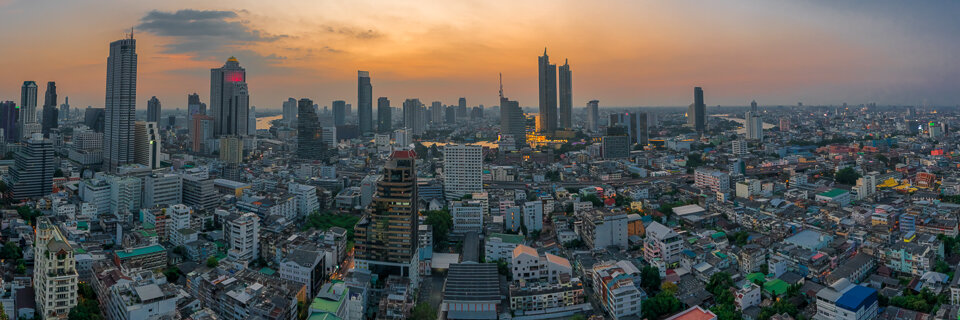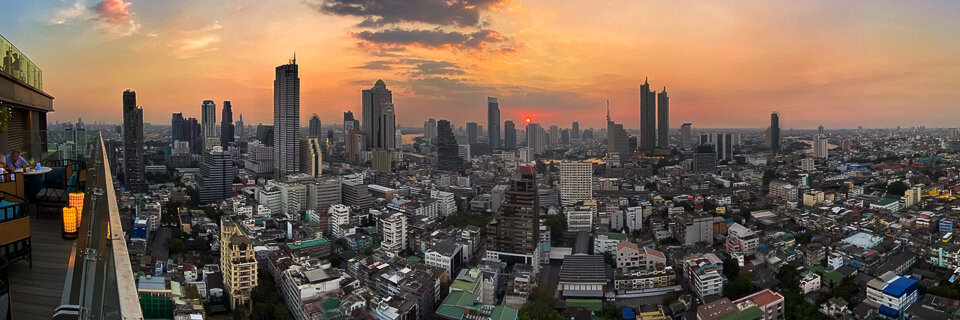The walls of the bot (the biggest and most sacred building in the temple) are sparkling with gilt and tinted glass, and - along the marble base - there are 112 golden garudas (birdmen) holding serpents – nagas. The exterior doors and windows of the bot are inlaid with beautiful mother of pearls designs. The staircase of the main entrance is guarded by Cambodian-style singhas (lions). The lower base of the bot is decorated with painted porcelain of flowers and birds on a light blue background (see the second picture). The roof is covered with blue, yellow and dark-orange glazed tiles.
Ściany bota (największej i najświętszej budowli świątyni) mienią się złoconym i przyciemnianym szkłem, a wzdłuż marmurowej podstawy znajduje się 112 złotych garudów (ptako-ludzi) trzymających węże - naga. Zewnętrzne drzwi i okna budynku są inkrustowane pięknymi wzorami z masy perłowej, zaś klatka schodowa głównego wejścia jest strzeżona przez singha (lwy) w kambodżańskim stylu. Dolna podstawa budynku jest ozdobiona malowaną porcelaną kwiatów i ptaków na jasnoniebieskim tle (zobacz drugie zdjęcie). Dach jest pokryty glazurą w kolorze niebieskim, żółtym i ciemno pomarańczowym
Inside the bot, on the 9-m high pedestal, there is a small figure of Emerald Buddha (probably from XV century), carved from a block of jade (nor emerald!). The statue is 66 cm tall, including the base and 48,3 cm wide. There are three different costumes of the Emerald Buddha, one of each season; they are summer (big crown and jewellery), rainy season (gilded monastic robe), and winter (a golden shawl). The first two seasons costumes were made in the reign of King Rama I, and the last one for winter was completed in the reign of King Rama III; all are made of gold and jewellery. The ceremony of changing the costume of the Emerald Buddha takes place three times a year, at the beginning of the new season, and is presided by the King.
Wewnątrz głównego budynku, na 9-metrowym cokole, znajduje się niewielka figura Szmaragdowego Buddy (prawdopodobnie z XV wieku), wyrzeźbiona z bloku jadeitu (nie szmaragdu!). Figura ma 66 cm wysokości łącznie z podstawą i 48,3 cm szerokości. Istnieją trzy różne kostiumy Szmaragdowego Buddy, po jednym na każdy sezon; na lato (duża korona i biżuteria), porę deszczową (pozłacana szata klasztorna) i zimę (złoty szal). Stroje na pierwsze dwa sezony powstały za panowania króla Ramy I, a ostatni, na zimę, za panowania króla Ramy III; wszystkie wykonane są ze złota i biżuterii. Ceremonia zmiany stroju Szmaragdowego Buddy odbywa się trzy razy w roku na początku nowego sezonu, a przewodniczy jej król.
In front of the main bot, devotees constantly make offering to the Emerald Buddha
Przed głównym budynkiem świątyni wielbiciele nieustannie składają ofiary Szmaragdowemu Buddzie
The Bell Tower (Ho Rakhang) is located to the south. It was initially built by Rama I but was completely rebuilt under Rama IV. The tower has an octagonal base, with four doors and protruding porticoes on each side. The bell is hung underneath a mondop-style spire. The entire structure is covered in coloured porcelain in floral and geometrical designs.
Dzwonnica (Ho Rakhang) znajduje się na południu kompleksu świątynnego. Początkowo została zbudowana przez Ramę I, ale była całkowicie przebudowana za Ramy IV. Wieża ma ośmioboczną podstawę, z czterema drzwiami i wystającymi portykami po każdej stronie. Dzwon jest zawieszony pod iglicą w stylu mondop. Całość pokryta jest kolorową porcelaną w kwiatowe i geometryczne wzory.
On the north of the temple area, Ho Phra Nak building was initially constructed by Rama I in the XVIII century as a temple for the Nak Buddha image from Ayutthaya. Rama III rebuilt it completely to house ashes of the minor royal family members.
W północnej części obszaru świątyni budynek Ho Phra Nak został pierwotnie zbudowany przez Ramę I w XVIII wieku jako świątynia dla obrazu Nak Buddy z Ayutthaya. Rama III całkowicie go jednak przebudował, aby pomieścić prochy pomniejszych członków rodziny królewskiej.
The Nak Buddha image was moved to a nearby building, Wihan Yot, shaped like a Greek cross and decorated with Chinese porcelain.
Wizerunek Nak Buddy został przeniesiony do pobliskiego budynku Wihan Yot, w kształcie greckiego krzyża i ozdobionego chińską porcelaną.
The last building in this area of the temple grounds is the Ho Phra Monthien Tham (auxiliary library), where many Buddhist scriptures are hold.
Ostatnim budynkiem na tym obszarze świątyni jest Ho Phra Monthien Tham (biblioteka pomocnicza), w której przechowywanych jest wiele buddyjskich pism świętych.
Two golden Phra Suvarna Chedi are situated to the east of the upper terrace, flanking the steps leading up to the Pantheon. They were built by Rama I to commemorate his father Thongdi and his mother Daoreung. Both chedi have a marble octagonal base 8.5 meters (28 ft) wide and topped with a golden, square-based stupa with triple indented corners 16 metres (52 ft) in height. The top spire is decorated in nine levels of layered lotus bud motifs. The structures are covered in copper sheets painted over with lacquer and gilded in gold leaf. Around the base of the chedi, there are figures from Ramakien story - four monkeys and sixteen giants around the sides.
Dwie złote Phra Suvarna Chedi znajdują się na wschód od górnego tarasu, flankując schody prowadzące do Panteonu. Zostały one zbudowane przez Ramę I dla upamiętnienia jego ojca Thongdiego i jego matki Daoreung. Obie chedi mają marmurową ośmiokątną podstawę o szerokości 8,5 metra i są zwieńczone złotą stupą na planie kwadratu z potrójnie wciętymi narożnikami o wysokości 16 metrów. Górna iglica jest ozdobiona dziewięcioma poziomami warstwowo ułożonych pączków lotosu. Stupa pokryta jest miedzią pomalowaną lakierem i nałożonymi płatkami złota. Wokół podstawy chedi znajdują się postacie z historii Ramakien - cztery małpy i szesnaście olbrzymów dookoła każdej z nich.
The row of eight prang, formally known as Phra Atsda Maha Chedi on the edge of the temple complex was built by Rama I and later covered in intricately coloured porcelain by Rama III. Each spire has an octagonal base with some decorations made of plaster. Each prang has four doorways with figures of golden standing devas on each side, above them are a band of supporting yaksha - giants from Ramakien story.
Rząd ośmiu prang, formalnie zwanych Phra Atsda Maha Chedi, na skraju kompleksu świątynnego został zbudowany przez Ramę I, a później pokryty misternie kolorową porcelaną przez Ramę III. Każda iglica ma ośmiokątną podstawę z dekoracjami wykonanymi z gipsu. Każdy prang ma cztery wejścia z postaciami złotych stojących dewów po każdej stronie, a nad nimi jest grupa yaksha - gigantów z Ramakien.
A Panom Mak sculpture, representing traditional offerings made of banana leaves and flowers, can be seen around the temple grounds.
Na terenie świątyni niejednokrotnie można zobaczyć rzeźbę Panom Mak, przedstawiającą tradycyjne ofiary złożone z liści bananowca i kwiatów.
A short video with the highlights of the temple
Krótki material filmowy ze świątyni

